Paul van Yperen's Blog, page 368
October 5, 2015
Imported from the USA: Douglas Fairbanks
On today's programme of Le Giornate del Cinema Muto in Pordenone is this afternoon The Mark of Zero (1920), with elegant, dashing, and athletic American actor Douglas Fairbanks (1883-1939) in one of his best swashbuckling roles. With his marriage to Mary Pickford in 1920, the couple became Hollywood royalty and Fairbanks was referred to as ‘The King of Hollywood'. His career rapidly declined with the advent of the 'talkies’. He finished his film career in Europe, with the British production The Private Life of Don Juan (1934).
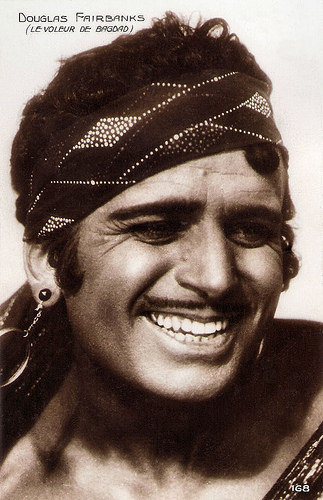
French postcard by Cinémagazine edition, no. 168. Sent by mail in Belgium in 1925. Photo: United Artists. Publicity still for The Thief of Bagdad (Raoul Walsh, 1924).
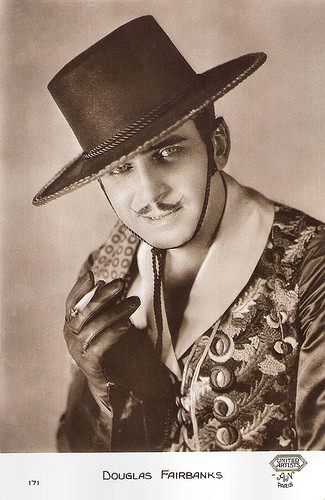
French postcard by A.N., Paris, no. 171. Photo: United Artists / Regal Film. Publicity still for Don Q Son of Zorro (Donald Crisp, 1925).
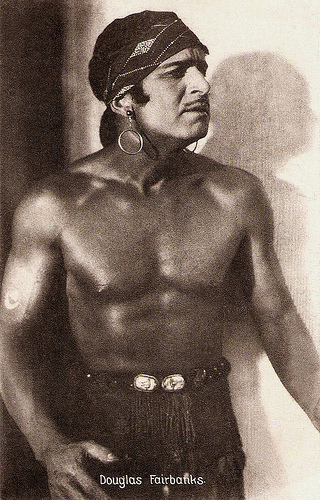
Swedish postcard by Stenders Kunstforlag, no. 37.
Free-wheeling farces
Douglas Fairbanks was born Douglas Elton Thomas Ullman in 1883 in Denver, Colorado, the son of H. Charles Ullman, a prominent New York attorney, and ‘Southern belle’ Ella Adelaide Marsh. Ullman abandoned the family when Douglas was five years old and he and his older brother Robert were brought up by their mother, who gave them the family name Fairbanks, after her first husband.
Douglas Fairbanks began acting at an early age, in amateur theatre on the Denver stage, performing in summer stock, and becoming a sensation in the local theatre community. Fairbanks moved to New York to pursue an acting career. He joined the acting troupe of British actor Frederick Warde who had seen Fairbanks performing in Denver. In 1902, he made his Broadway debut as Florio in the Frederick Warde Company's production of The Duke's Jester.
In 1907, Fairbanks married Anna Beth Sully, the daughter of a wealthy industrialist. They had one son, Douglas Elton Fairbanks (1909), who later became known as actor Douglas Fairbanks Jr. In 1915, the family moved to Los Angeles. The then 31-years old Fairbanks signed a contract with Triangle Pictures and began working under the supervision of D.W. Griffith.
His first film was titled The Lamb (W. Christy Cabanne, 1915), in which he debuted the athletic abilities that would gain him wide attention among theatre audiences. His athleticism was not appreciated by Griffith, however, and he was brought to the attention of Anita Loos and John Emerson, who wrote and directed many of his next films.
Fairbanks became the top moneymaker for Triangle, starring in an average of 10 pictures a year for a weekly salary of $2000. He specialized in comedies-not the slapstick variety, but free-wheeling farces in which he usually played a wealthy young man thirsting for adventure. In 1916, Fairbanks established his own company, the Douglas Fairbanks Film Corporation, and would soon get a job at Paramount. His films ranged from romances to wacky, madcap comedies; from social satires to westerns.
At a party in 1916, Fairbanks met actress Mary Pickford, and the couple began an affair. In 1917, they joined Fairbanks's friend Charlie Chaplin selling war bonds by train across the U.S. Pickford and Chaplin were then the two highest paid film stars in Hollywood. To curtail these stars' astronomical salaries, the large studios attempted to monopolize distributors and exhibitors. By 1918, Fairbanks was Hollywood's most popular actor, and within three years of his arrival Fairbanks's popularity and business acumen raised him to the third-highest paid.
In late 1918, Sully was granted a divorce from Fairbanks, the judgment being finalized in early 1919. To avoid being controlled by the studios and to protect their independence, Fairbanks, Pickford, Chaplin, and D. W. Griffith formed United Artists in 1919, which created their own distributorships and gave them complete artistic control over their films and the profits generated. The company was kept solvent in the years immediately after its formation largely by the success of Fairbanks's films.
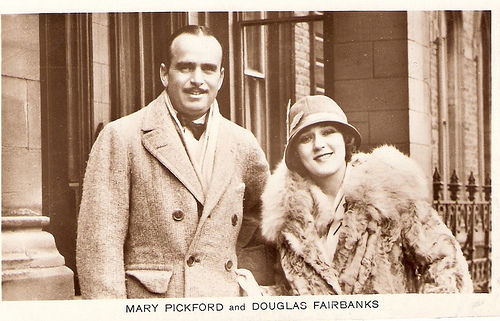
Douglas Fairbanks and Mary Pickford. This postcard was probably issued for their European honeymoon tour in 1921. They look quite happy here, but in London, Pickford was dragged from her car and trampled by fanatics fans who wanted to touch her hair & clothes.
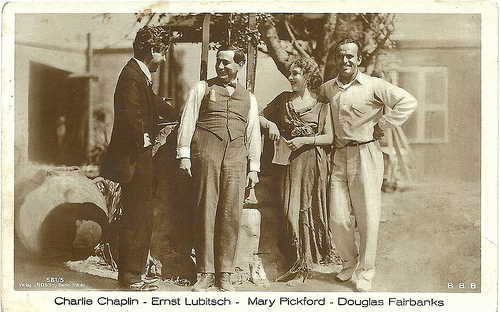
Charlie Chaplin , Ernst Lubitsch, Mary Pickford and Douglas Fairbanks. German postcard by Ross Verlag, no. 581/5, 1919-1924. Photo: B.B.B. Collection: Didier Hanson.
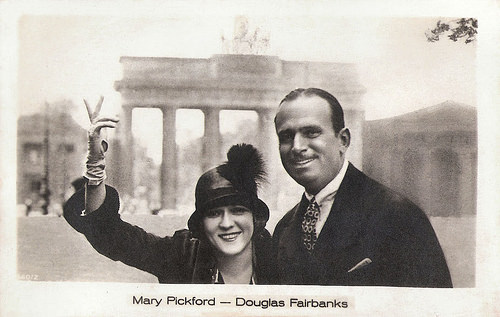
Douglas Fairbanks and Mary Pickford in Berlin. Vintage postcard, no. 960/2. Probably a vintage reprint of a Ross Verlag postcard. In 1926, Pickford and Fairbanks visited Berlin and stayed at the Hotel Adlon near the Brandenburg Gate, which is in the background of this picture.
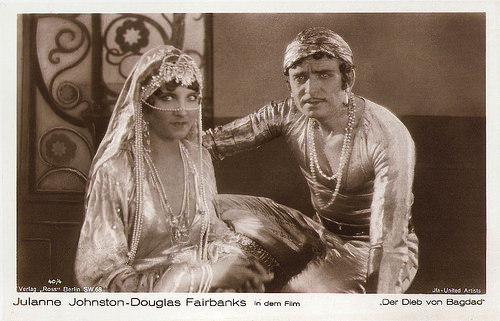
German postcard by Ross Verlag, Berlin, no. 40/4. Photo: IFA / United Artists. Publicity still for The Thief of Bagdad (Raoul Walsh, 1924). Julanne Johnston played the Princess.
‘Everybody's Hero’ and ‘America's Sweetheart
Douglas Fairbanks was determined to have Mary Pickford become his wife, but she was still married to actor Owen Moore. He finally gave her an ultimatum. She then obtained a fast divorce in the small Nevada town of Minden and the couple married in 1920. The public went wild over the idea of ‘Everybody's Hero’ marrying ‘America's Sweetheart.’ They were greeted by large crowds in London, Amsterdam and Paris during their European honeymoon, becoming Hollywood's first celebrity couple. Fairbanks and Pickford were regarded as ‘Hollywood Royalty,’ famous for entertaining at their 42-room mansion in Beverly Hills, Pickfair.
By 1920, Fairbanks had completed twenty-nine films (twenty-eight features and one two-reel short), which showcased his ebullient screen persona and athletic ability. By 1920, he had the inspiration of staging a new type of adventure-costume picture, a genre that was then out of favor with the public; Fairbanks had been a comic in his previous films.
In The Mark of Zorro (Fred Niblo, 1920), Fairbanks combined his appealing screen persona with the new adventurous costume element. This genre-defining swashbuckler adventure was the first film version of The Mark of Zorro. It was a smash success and parlayed the actor into the rank of superstar.
For the remainder of his career in silent films he continued to produce and star in ever more elaborate, impressive costume films, such as The Three Musketeers (Fred Niblo, 1921), Robin Hood (Allan Dwan, 1922), The Thief of Bagdad (Raoul Walsh, 1924), The Black Pirate (Albert Parker, 1926, the first full-length Technicolor film), and The Gaucho (F. Richard Jones, 1927) with Lupe Velez.
Fairbanks spared no expense and effort in these films, which established the standard for all future swashbuckling films. In 1921, he, Mary Pickford, Charles Chaplin , and others, helped to organize the Motion Picture Fund to assist those in the industry who could not work, or were unable to meet their bills. During the first ceremony of its type, in 1927, Fairbanks and Pickford placed their hand and foot prints in wet cement at the newly opened Grauman's Chinese Theatre in Hollywood. Fairbanks was elected first President of the Motion Picture Academy of Arts and Sciences that same year, and he presented the first Academy Awards at the Roosevelt Hotel. Today, Fairbanks also has a star on the Hollywood Walk of Fame at 7020 Hollywood Boulevard.
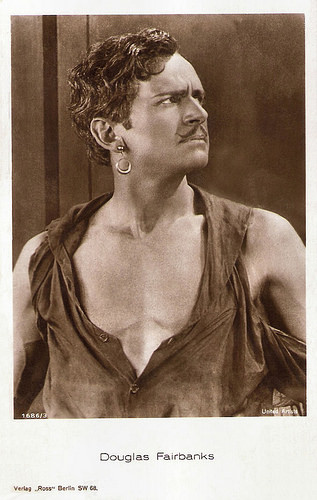
German postcard by Ross-Verlag, no. 1686/3, 1927-1928. Photo: United Artists. Publicity still for The Black Pirate (Albert Parker, 1926).
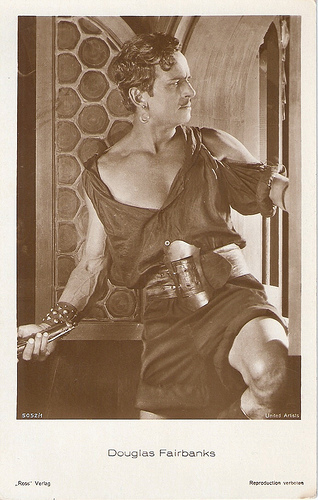
German postcard by Ross Verlag, no. 5052/1, 1930-1931. Photo: United Artists. Publicity still for the silent adventure film The Black Pirate (Albert Parker, 1926).
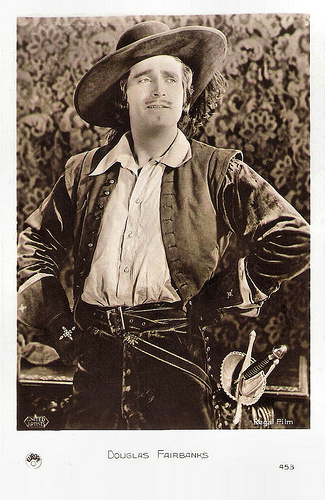
French postcard by Europe, no. 453. Photo: United Artists / Regal Film. Publicity still for The Iron Mask (Allan Dwan, 1929).
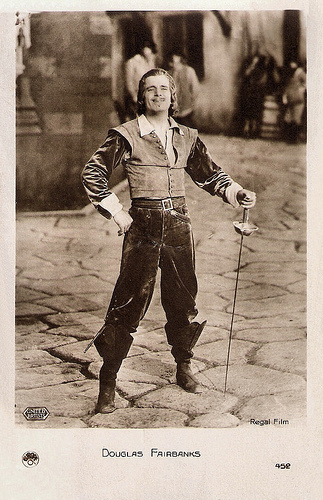
French postcard by Europe, no. 452. Photo: United Artists / Regal Film. Publicity still for The Iron Mask (Allan Dwan, 1929).
Colossal Disaster
While Douglas Fairbanks had flourished in the silent genre, the restrictions of early sound films dulled his enthusiasm for film-making. He was 44 years old, and could no longer look the part of the youthful swashbuckler or romantic lead, nor could he safely perform the dangerous stunts his audiences expected of him.
In 1929, at Pickford's bungalow, United Artists brought together Pickford, Fairbanks, Charles Chaplin , Norma Talmadge, Gloria Swanson, John Barrymore, D.W. Griffith and Dolores del Rio to speak on the radio show The Dodge Brothers Hour to prove Fairbanks could meet the challenge of talking movies.
Fairbanks's last silent film was the lavish The Iron Mask (Allan Dwan, 1929), a sequel to The Three Musketeers (Fred Niblo, 1921). The Iron Mask included an introductory prologue spoken by Fairbanks. He and Pickford chose to make their first talkie as a joint venture, playing Petruchio and Kate in William Shakespeare's The Taming of the Shrew (Sam Taylor, 1929). The film was a colossal disaster, and the pair fought constantly during it's making. When it flopped at the box office, Doug and Mary blamed each other.
Doug’s subsequent sound films, were also poorly received by Depression-era audiences. The last film in which he acted was the British production The Private Life of Don Juan (Alexander Korda, 1934), with Merle Oberon . The film is a revealing look at the life of the aging Don Juan, whose reputation has outrun him. The film, based on the 1920 play L'homme à la Rose by Henry Bataille, was made by Korda's London Film Productions at Elstree Studios and distributed by United Artists under an agreement Korda had recently signed with them.
Fairbanks and Pickford separated in 1933, after he began an affair with Sylvia, Lady Ashley. They divorced in 1936, with Pickford keeping the Pickfair estate. Within months Fairbanks and Ashley were married in Paris. He continued to be marginally involved in the film industry and was disturbed by the new direction of his own company, United Artists, now under the iron fist of Samuel Goldwyn. His health continued to decline, and in his final years he lived in Santa Monica, California, although much of his time was spent traveling abroad with Sylvia. At the end of 1939, Fairbanks had a mild heart attack. He died later that day at his home in Santa Monica. He was 56. Fairbanks's famous last words were, "I've never felt better."
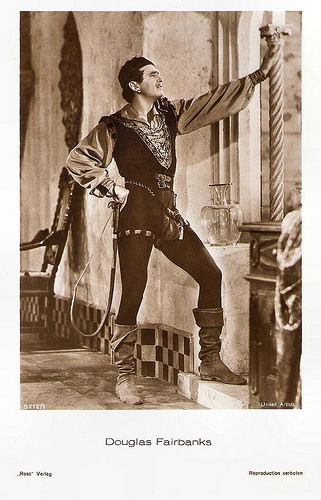
German postcard by Ross-Verlag, no. 5212/1, 1930-1931. Photo: United Artists. Publicity still for The Taming of the Shrew (Sam Taylor, 1930).
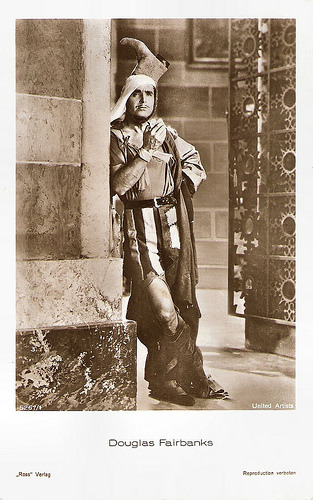
German postcard by Ross-Verlag, no. 5267/1, 1930-1931. Photo: United Artists. Publicity still for The Taming of the Shrew (Sam Taylor, 1930).
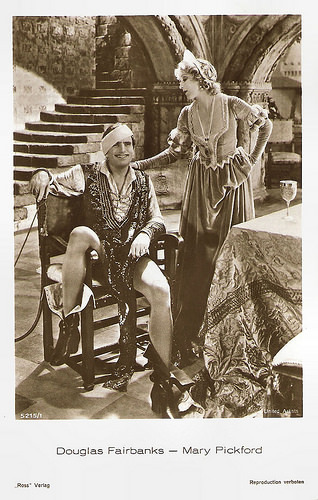
German postcard by Ross-Verlag, no. 5215/4 1930-1931. Photo: United Artists. Publicity still for The Taming of the Shrew (Sam Taylor, 1930) with Mary Pickford.
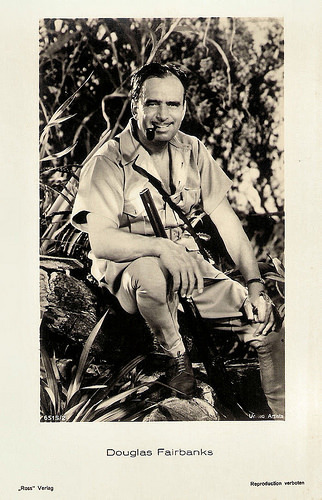
German postcard by Ross-Verlag, no. 6515/2, 1931-1932. Photo: United Artists. Publicity still for Mr. Robinson Crusoe (Edward Sutherland, 1932).
Sources: Hal Erickson (AllMovie), (IMDb), The Douglas Fairbanks Museum, Wikipedia and .

French postcard by Cinémagazine edition, no. 168. Sent by mail in Belgium in 1925. Photo: United Artists. Publicity still for The Thief of Bagdad (Raoul Walsh, 1924).

French postcard by A.N., Paris, no. 171. Photo: United Artists / Regal Film. Publicity still for Don Q Son of Zorro (Donald Crisp, 1925).

Swedish postcard by Stenders Kunstforlag, no. 37.
Free-wheeling farces
Douglas Fairbanks was born Douglas Elton Thomas Ullman in 1883 in Denver, Colorado, the son of H. Charles Ullman, a prominent New York attorney, and ‘Southern belle’ Ella Adelaide Marsh. Ullman abandoned the family when Douglas was five years old and he and his older brother Robert were brought up by their mother, who gave them the family name Fairbanks, after her first husband.
Douglas Fairbanks began acting at an early age, in amateur theatre on the Denver stage, performing in summer stock, and becoming a sensation in the local theatre community. Fairbanks moved to New York to pursue an acting career. He joined the acting troupe of British actor Frederick Warde who had seen Fairbanks performing in Denver. In 1902, he made his Broadway debut as Florio in the Frederick Warde Company's production of The Duke's Jester.
In 1907, Fairbanks married Anna Beth Sully, the daughter of a wealthy industrialist. They had one son, Douglas Elton Fairbanks (1909), who later became known as actor Douglas Fairbanks Jr. In 1915, the family moved to Los Angeles. The then 31-years old Fairbanks signed a contract with Triangle Pictures and began working under the supervision of D.W. Griffith.
His first film was titled The Lamb (W. Christy Cabanne, 1915), in which he debuted the athletic abilities that would gain him wide attention among theatre audiences. His athleticism was not appreciated by Griffith, however, and he was brought to the attention of Anita Loos and John Emerson, who wrote and directed many of his next films.
Fairbanks became the top moneymaker for Triangle, starring in an average of 10 pictures a year for a weekly salary of $2000. He specialized in comedies-not the slapstick variety, but free-wheeling farces in which he usually played a wealthy young man thirsting for adventure. In 1916, Fairbanks established his own company, the Douglas Fairbanks Film Corporation, and would soon get a job at Paramount. His films ranged from romances to wacky, madcap comedies; from social satires to westerns.
At a party in 1916, Fairbanks met actress Mary Pickford, and the couple began an affair. In 1917, they joined Fairbanks's friend Charlie Chaplin selling war bonds by train across the U.S. Pickford and Chaplin were then the two highest paid film stars in Hollywood. To curtail these stars' astronomical salaries, the large studios attempted to monopolize distributors and exhibitors. By 1918, Fairbanks was Hollywood's most popular actor, and within three years of his arrival Fairbanks's popularity and business acumen raised him to the third-highest paid.
In late 1918, Sully was granted a divorce from Fairbanks, the judgment being finalized in early 1919. To avoid being controlled by the studios and to protect their independence, Fairbanks, Pickford, Chaplin, and D. W. Griffith formed United Artists in 1919, which created their own distributorships and gave them complete artistic control over their films and the profits generated. The company was kept solvent in the years immediately after its formation largely by the success of Fairbanks's films.

Douglas Fairbanks and Mary Pickford. This postcard was probably issued for their European honeymoon tour in 1921. They look quite happy here, but in London, Pickford was dragged from her car and trampled by fanatics fans who wanted to touch her hair & clothes.

Charlie Chaplin , Ernst Lubitsch, Mary Pickford and Douglas Fairbanks. German postcard by Ross Verlag, no. 581/5, 1919-1924. Photo: B.B.B. Collection: Didier Hanson.

Douglas Fairbanks and Mary Pickford in Berlin. Vintage postcard, no. 960/2. Probably a vintage reprint of a Ross Verlag postcard. In 1926, Pickford and Fairbanks visited Berlin and stayed at the Hotel Adlon near the Brandenburg Gate, which is in the background of this picture.

German postcard by Ross Verlag, Berlin, no. 40/4. Photo: IFA / United Artists. Publicity still for The Thief of Bagdad (Raoul Walsh, 1924). Julanne Johnston played the Princess.
‘Everybody's Hero’ and ‘America's Sweetheart
Douglas Fairbanks was determined to have Mary Pickford become his wife, but she was still married to actor Owen Moore. He finally gave her an ultimatum. She then obtained a fast divorce in the small Nevada town of Minden and the couple married in 1920. The public went wild over the idea of ‘Everybody's Hero’ marrying ‘America's Sweetheart.’ They were greeted by large crowds in London, Amsterdam and Paris during their European honeymoon, becoming Hollywood's first celebrity couple. Fairbanks and Pickford were regarded as ‘Hollywood Royalty,’ famous for entertaining at their 42-room mansion in Beverly Hills, Pickfair.
By 1920, Fairbanks had completed twenty-nine films (twenty-eight features and one two-reel short), which showcased his ebullient screen persona and athletic ability. By 1920, he had the inspiration of staging a new type of adventure-costume picture, a genre that was then out of favor with the public; Fairbanks had been a comic in his previous films.
In The Mark of Zorro (Fred Niblo, 1920), Fairbanks combined his appealing screen persona with the new adventurous costume element. This genre-defining swashbuckler adventure was the first film version of The Mark of Zorro. It was a smash success and parlayed the actor into the rank of superstar.
For the remainder of his career in silent films he continued to produce and star in ever more elaborate, impressive costume films, such as The Three Musketeers (Fred Niblo, 1921), Robin Hood (Allan Dwan, 1922), The Thief of Bagdad (Raoul Walsh, 1924), The Black Pirate (Albert Parker, 1926, the first full-length Technicolor film), and The Gaucho (F. Richard Jones, 1927) with Lupe Velez.
Fairbanks spared no expense and effort in these films, which established the standard for all future swashbuckling films. In 1921, he, Mary Pickford, Charles Chaplin , and others, helped to organize the Motion Picture Fund to assist those in the industry who could not work, or were unable to meet their bills. During the first ceremony of its type, in 1927, Fairbanks and Pickford placed their hand and foot prints in wet cement at the newly opened Grauman's Chinese Theatre in Hollywood. Fairbanks was elected first President of the Motion Picture Academy of Arts and Sciences that same year, and he presented the first Academy Awards at the Roosevelt Hotel. Today, Fairbanks also has a star on the Hollywood Walk of Fame at 7020 Hollywood Boulevard.

German postcard by Ross-Verlag, no. 1686/3, 1927-1928. Photo: United Artists. Publicity still for The Black Pirate (Albert Parker, 1926).

German postcard by Ross Verlag, no. 5052/1, 1930-1931. Photo: United Artists. Publicity still for the silent adventure film The Black Pirate (Albert Parker, 1926).

French postcard by Europe, no. 453. Photo: United Artists / Regal Film. Publicity still for The Iron Mask (Allan Dwan, 1929).

French postcard by Europe, no. 452. Photo: United Artists / Regal Film. Publicity still for The Iron Mask (Allan Dwan, 1929).
Colossal Disaster
While Douglas Fairbanks had flourished in the silent genre, the restrictions of early sound films dulled his enthusiasm for film-making. He was 44 years old, and could no longer look the part of the youthful swashbuckler or romantic lead, nor could he safely perform the dangerous stunts his audiences expected of him.
In 1929, at Pickford's bungalow, United Artists brought together Pickford, Fairbanks, Charles Chaplin , Norma Talmadge, Gloria Swanson, John Barrymore, D.W. Griffith and Dolores del Rio to speak on the radio show The Dodge Brothers Hour to prove Fairbanks could meet the challenge of talking movies.
Fairbanks's last silent film was the lavish The Iron Mask (Allan Dwan, 1929), a sequel to The Three Musketeers (Fred Niblo, 1921). The Iron Mask included an introductory prologue spoken by Fairbanks. He and Pickford chose to make their first talkie as a joint venture, playing Petruchio and Kate in William Shakespeare's The Taming of the Shrew (Sam Taylor, 1929). The film was a colossal disaster, and the pair fought constantly during it's making. When it flopped at the box office, Doug and Mary blamed each other.
Doug’s subsequent sound films, were also poorly received by Depression-era audiences. The last film in which he acted was the British production The Private Life of Don Juan (Alexander Korda, 1934), with Merle Oberon . The film is a revealing look at the life of the aging Don Juan, whose reputation has outrun him. The film, based on the 1920 play L'homme à la Rose by Henry Bataille, was made by Korda's London Film Productions at Elstree Studios and distributed by United Artists under an agreement Korda had recently signed with them.
Fairbanks and Pickford separated in 1933, after he began an affair with Sylvia, Lady Ashley. They divorced in 1936, with Pickford keeping the Pickfair estate. Within months Fairbanks and Ashley were married in Paris. He continued to be marginally involved in the film industry and was disturbed by the new direction of his own company, United Artists, now under the iron fist of Samuel Goldwyn. His health continued to decline, and in his final years he lived in Santa Monica, California, although much of his time was spent traveling abroad with Sylvia. At the end of 1939, Fairbanks had a mild heart attack. He died later that day at his home in Santa Monica. He was 56. Fairbanks's famous last words were, "I've never felt better."

German postcard by Ross-Verlag, no. 5212/1, 1930-1931. Photo: United Artists. Publicity still for The Taming of the Shrew (Sam Taylor, 1930).

German postcard by Ross-Verlag, no. 5267/1, 1930-1931. Photo: United Artists. Publicity still for The Taming of the Shrew (Sam Taylor, 1930).

German postcard by Ross-Verlag, no. 5215/4 1930-1931. Photo: United Artists. Publicity still for The Taming of the Shrew (Sam Taylor, 1930) with Mary Pickford.

German postcard by Ross-Verlag, no. 6515/2, 1931-1932. Photo: United Artists. Publicity still for Mr. Robinson Crusoe (Edward Sutherland, 1932).
Sources: Hal Erickson (AllMovie), (IMDb), The Douglas Fairbanks Museum, Wikipedia and .
Published on October 05, 2015 22:00
October 4, 2015
Twelve silent cowboys
One of the programs of this year's Le Giornate del Cinema Muto in Pordenone is 'Birth of the Western'. As a tribute to the heroes of the early Western, today at EFSP twelve postcards of legendary silent film cowboys.
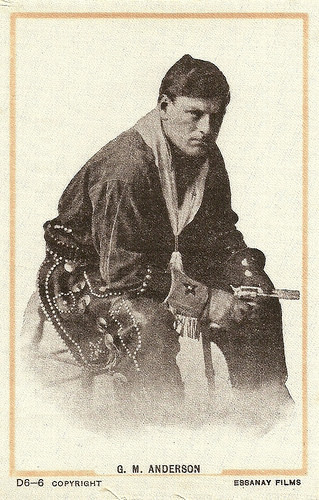
British or American postcard in the Novelty Series, no. D6-6. Photo: Essanay Films.
The first star of the Western was American actor, writer, film director, and producer Gilbert M. 'Broncho Billy' Anderson (1880-1971). Anderson played three roles in the first Western, The Great Train Robbery (Edwin S. Porter, 1903). He directed and starred in almost 400 Broncho Billy films over a seven year period.
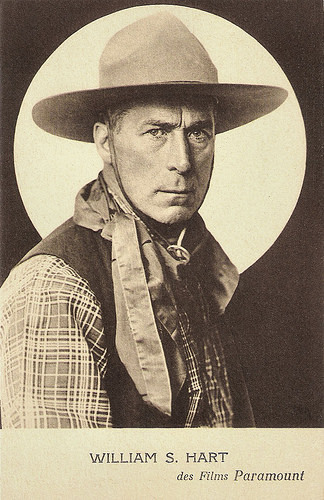
French postcard by Edition Paramount, Paris.
William Surrey Hart (1864–1946) was an American silent film actor, screenwriter, director and producer. He entered films in 1914 where, after playing supporting roles in two short films, he achieved stardom as the lead in The Bargain (Reginald Barker, 1914), his first Western. He became a foremost Western star of the silent era who played characters with honor and integrity. Hart was particularly interested in making realistic Westerns, and his films are noted for their authentic costumes and props. Hart also had an extraordinary acting ability, honed on Shakespearean theatre stages in the United States and England.
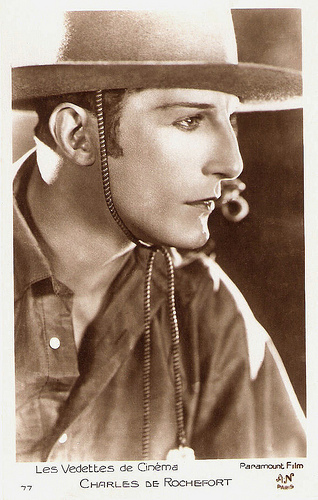
French postcard by A.N., Paris, in the series Les Vedettes de Cinéma, no. 77. Photo: Paramount Film.
Europe had its own Western heroes, like Charles de Rochefort (1887-1952),a star of the French silent cinema. He appeared in 34 films between 1911 and 1932, including Westerns like Roi de Camargue/King of Camargue (André Hugon, 1921). In 1923 he went to the US and made several films in Hollywood. After his return to France, he became a film director of sound films.
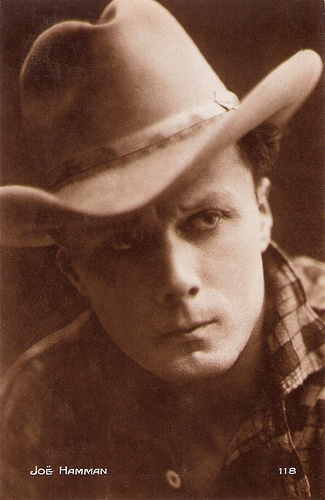
French postcard by Editions Cinémagazine, no. 118.
Joë Hamman (1883-1974) was another French equivalent of the cowboy. Hamman played in many French Westerns, often filmed in the Camargue in the South of France. In 1907 Hamman started out as both actor and director of Le desperado, followed by performances in some 40 other short westerns until early 1914. These include Un drame mexicain (1909), Un drame au Far West (1909), the tree-part sequel Le vautour de la Sierra (Victorine-Hipolyte Jasset, 1909), Les aventures de Buffalo Bill (1911), and Le railway de la mort (Jean Durand, 1912). He had a long ranging career till 1967, and was also an affluent film director.
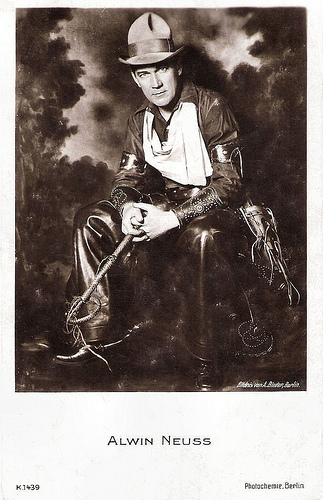
German postcard by Photochemie, Berlin, no. K 1439. Photo: Alex Binder, Berlin.
German actor and director Alwin Neuss (1879-1935) also starred in some European Westerns. He started his film career at the pioneering Nordisk studio in Denmark, and was also known for playing Sherlock Holmes in a series of silent films during the 1910s.
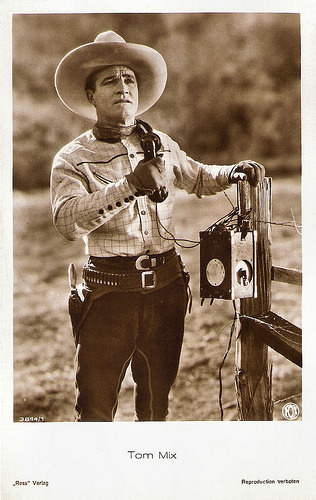
German postcard by Ross Verlag, Berlin, no. 3844/1, 1928-1929. Photo: Fox.
American film actor Tom Mix (1880–1940) was the star of many early Westerns between 1909 and 1935. Mix appeared in 291 films, all but nine of which were silent movies. He was Hollywood's first Western megastar and helped to define the genre for all cowboy actors who followed. He developed a comical style, emphasizing fast action thrills to a greater extent than had been common in earlier Westerns, and he did his own stunts. In addition to Mix's riding and shooting skills, the films also showcased the talents of his amazing horse, Tony the Horse.
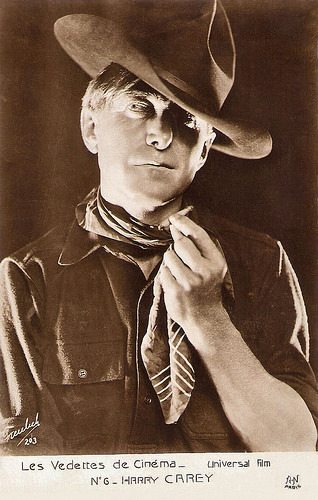
French postcard by A.N., Paris, in the series Les Vedettes de Cinema, no. 6. Photo: Universal Film / Roman Freulich, no. 203.
One of silent film's earliest superstars was American actor and cowboy Harry Carey (1878-1947). Carey's rugged frame and weather-beaten face were well suited to Westerns. One of his most popular roles was as the good-hearted outlaw Cheyenne Harry. Carey discovered director John Ford and starred in Ford's first feature film, Straight Shooting (John Ford, 1918). He was the father of Harry Carey Jr., who also became a prominent Western actor.
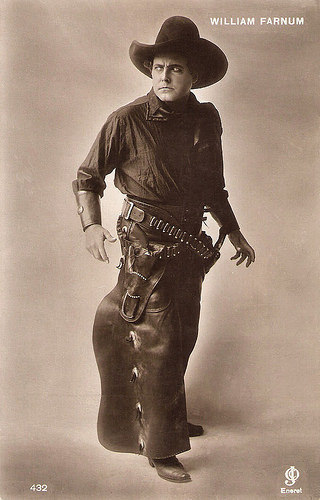
Danish postcard by J. Chr. Olsens Kunstforlag. Eneret, no. 432.
From 1914 to 1925, American actor William Farnum (1876-1953) was one of the biggest sensations in Hollywood, earning $10,000 a week. Farnum's silent pictures include the Westerns The Spoilers (1914) - which culminates in a spectacular saloon fistfight, Drag Harlan (1920) and the drama-adventure If I Were King (1921).
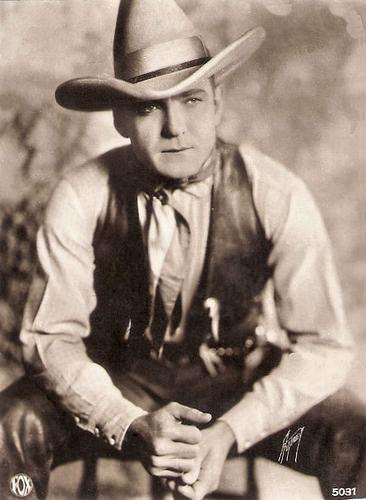
French postcard, no. 5031. Photo: Autrey / Fox.
American film star Buck Jones (1891–1942) starred in many popular B-Westerns of the 1920s, 1930s, and 1940s. Executive William Fox decided to use him as a backup to Tom Mix. This led to his first starring role, The Last Straw (Denison Clift, Charles Swickard, 1920). With his famed horse Silver, Jones would make more than 160 films credits.
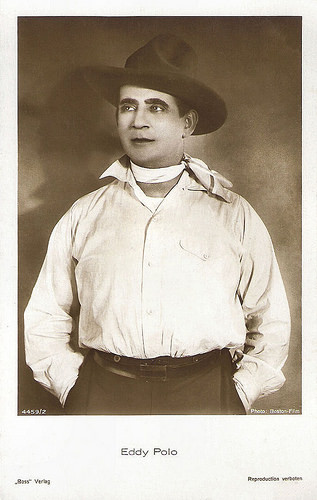
German postcard by Ross Verlag, no. 4469/2, 1929-1930. Photo: Boston Film.
Eddie Polo (1875–1961) was an Austro-American actor of the silent era. He was born Edward W. Wyman or Weimer in Vienna, Austria-Hungary. With his brother Sam he was the trapeze act The Flying Cordovas. He was the first man to parachute off the Eiffel Tower. Beginning in 1913, he appeared in serials and films in the USA and as Cyclone Smith, he became a popular Western hero. During the late 1920s, he was an action star in the German silent cinema. After his acting career ended in the mid-1940s he worked as a makeup artist.
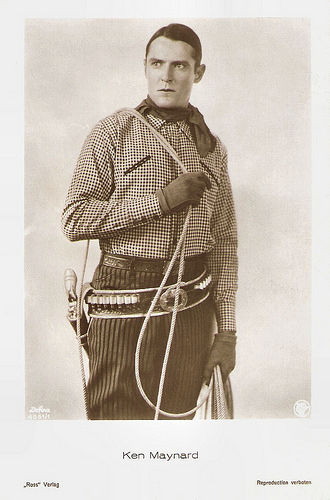
German postcard by Ross Verlag, no. 4561/1, 1929-1930. Photo: Defina / First National Pictures.
Ken Maynard (1895–1973) was one the superstars among the film cowboys. Reportedly, he began his career as a trick rider with the Buffalo Bill Wild West Show and later with Ringling Brothers (some sources deny this). From 1924 on, he worked in Hollywood and made some 20 silent westerns. He was famous for the stunts he could enact with his horse Tarzan. Maynard was the first singing cowboy in the movies.
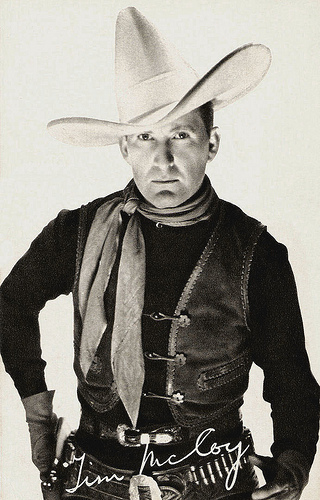
British postcard by Rotogravure. Photo: Columbia Pictures.
Light-haired and blue-eyed American actor Tim McCoy (1891–1978) was one of the great stars of the early Western. He was also a decorated military officer and expert on American Indian life and customs. As a cowboy star, he was so popular with kids that he appeared on the cover of Wheaties cereal boxes.
That's all, folks!
Sources: Wikipedia and IMDb.

British or American postcard in the Novelty Series, no. D6-6. Photo: Essanay Films.
The first star of the Western was American actor, writer, film director, and producer Gilbert M. 'Broncho Billy' Anderson (1880-1971). Anderson played three roles in the first Western, The Great Train Robbery (Edwin S. Porter, 1903). He directed and starred in almost 400 Broncho Billy films over a seven year period.

French postcard by Edition Paramount, Paris.
William Surrey Hart (1864–1946) was an American silent film actor, screenwriter, director and producer. He entered films in 1914 where, after playing supporting roles in two short films, he achieved stardom as the lead in The Bargain (Reginald Barker, 1914), his first Western. He became a foremost Western star of the silent era who played characters with honor and integrity. Hart was particularly interested in making realistic Westerns, and his films are noted for their authentic costumes and props. Hart also had an extraordinary acting ability, honed on Shakespearean theatre stages in the United States and England.

French postcard by A.N., Paris, in the series Les Vedettes de Cinéma, no. 77. Photo: Paramount Film.
Europe had its own Western heroes, like Charles de Rochefort (1887-1952),a star of the French silent cinema. He appeared in 34 films between 1911 and 1932, including Westerns like Roi de Camargue/King of Camargue (André Hugon, 1921). In 1923 he went to the US and made several films in Hollywood. After his return to France, he became a film director of sound films.

French postcard by Editions Cinémagazine, no. 118.
Joë Hamman (1883-1974) was another French equivalent of the cowboy. Hamman played in many French Westerns, often filmed in the Camargue in the South of France. In 1907 Hamman started out as both actor and director of Le desperado, followed by performances in some 40 other short westerns until early 1914. These include Un drame mexicain (1909), Un drame au Far West (1909), the tree-part sequel Le vautour de la Sierra (Victorine-Hipolyte Jasset, 1909), Les aventures de Buffalo Bill (1911), and Le railway de la mort (Jean Durand, 1912). He had a long ranging career till 1967, and was also an affluent film director.

German postcard by Photochemie, Berlin, no. K 1439. Photo: Alex Binder, Berlin.
German actor and director Alwin Neuss (1879-1935) also starred in some European Westerns. He started his film career at the pioneering Nordisk studio in Denmark, and was also known for playing Sherlock Holmes in a series of silent films during the 1910s.

German postcard by Ross Verlag, Berlin, no. 3844/1, 1928-1929. Photo: Fox.
American film actor Tom Mix (1880–1940) was the star of many early Westerns between 1909 and 1935. Mix appeared in 291 films, all but nine of which were silent movies. He was Hollywood's first Western megastar and helped to define the genre for all cowboy actors who followed. He developed a comical style, emphasizing fast action thrills to a greater extent than had been common in earlier Westerns, and he did his own stunts. In addition to Mix's riding and shooting skills, the films also showcased the talents of his amazing horse, Tony the Horse.

French postcard by A.N., Paris, in the series Les Vedettes de Cinema, no. 6. Photo: Universal Film / Roman Freulich, no. 203.
One of silent film's earliest superstars was American actor and cowboy Harry Carey (1878-1947). Carey's rugged frame and weather-beaten face were well suited to Westerns. One of his most popular roles was as the good-hearted outlaw Cheyenne Harry. Carey discovered director John Ford and starred in Ford's first feature film, Straight Shooting (John Ford, 1918). He was the father of Harry Carey Jr., who also became a prominent Western actor.

Danish postcard by J. Chr. Olsens Kunstforlag. Eneret, no. 432.
From 1914 to 1925, American actor William Farnum (1876-1953) was one of the biggest sensations in Hollywood, earning $10,000 a week. Farnum's silent pictures include the Westerns The Spoilers (1914) - which culminates in a spectacular saloon fistfight, Drag Harlan (1920) and the drama-adventure If I Were King (1921).

French postcard, no. 5031. Photo: Autrey / Fox.
American film star Buck Jones (1891–1942) starred in many popular B-Westerns of the 1920s, 1930s, and 1940s. Executive William Fox decided to use him as a backup to Tom Mix. This led to his first starring role, The Last Straw (Denison Clift, Charles Swickard, 1920). With his famed horse Silver, Jones would make more than 160 films credits.

German postcard by Ross Verlag, no. 4469/2, 1929-1930. Photo: Boston Film.
Eddie Polo (1875–1961) was an Austro-American actor of the silent era. He was born Edward W. Wyman or Weimer in Vienna, Austria-Hungary. With his brother Sam he was the trapeze act The Flying Cordovas. He was the first man to parachute off the Eiffel Tower. Beginning in 1913, he appeared in serials and films in the USA and as Cyclone Smith, he became a popular Western hero. During the late 1920s, he was an action star in the German silent cinema. After his acting career ended in the mid-1940s he worked as a makeup artist.

German postcard by Ross Verlag, no. 4561/1, 1929-1930. Photo: Defina / First National Pictures.
Ken Maynard (1895–1973) was one the superstars among the film cowboys. Reportedly, he began his career as a trick rider with the Buffalo Bill Wild West Show and later with Ringling Brothers (some sources deny this). From 1924 on, he worked in Hollywood and made some 20 silent westerns. He was famous for the stunts he could enact with his horse Tarzan. Maynard was the first singing cowboy in the movies.

British postcard by Rotogravure. Photo: Columbia Pictures.
Light-haired and blue-eyed American actor Tim McCoy (1891–1978) was one of the great stars of the early Western. He was also a decorated military officer and expert on American Indian life and customs. As a cowboy star, he was so popular with kids that he appeared on the cover of Wheaties cereal boxes.
That's all, folks!
Sources: Wikipedia and IMDb.
Published on October 04, 2015 22:00
October 3, 2015
Luciano Albertini
We are in Italy for Le Giornate del Cinema Muto in Pordenone, the festival of the silent film. One of the programmes of the festival is about the forzuti, the Italian strong men, and their work for the German silent cinema. The programme is selected by my partner, film historian Ivo Blom, who often conntributes to this blog. Today, I've planned to see see Der Unüberwindliche/The Invincible (Max Obal, 1928), accompanied by the Zerochestra. Star of the film is Luciano Albertini (1882-1945), who was one of the most famous strongmen and daredevils of the silent cinema. The former circus artist first worked as an actor and producer for the Italian cinema and later moved to Berlin, where his Latin appeal made many admirers swoon. He also filmed for Universal in the USA.
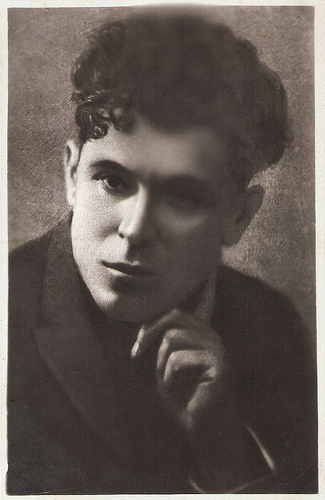
American postcard by A.G.F. Photo: Photocine.
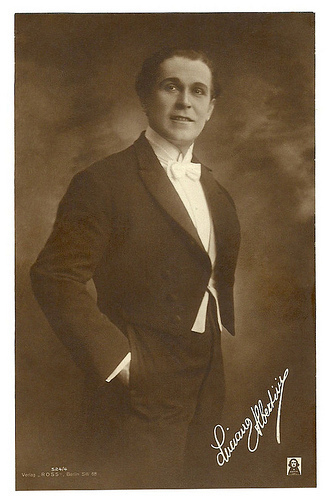
German postcard by Ross Verlag, Berlin, no. 524/4, 1919-1924. Collection: Didier Hanson.
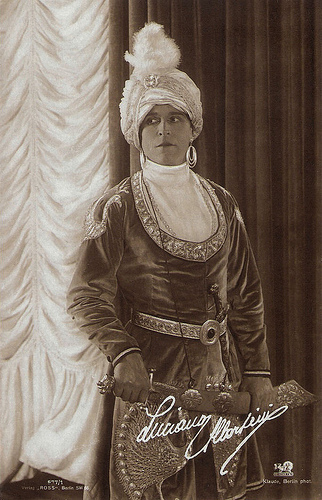
German postcard by Ross Verlag, no. 577/1, 1919-1924. Photo: Klaude, Berlin / Phoebus-Film. Publicity still for Der Sieg des Maharadscha/The victory of the Maharajah (Joseph Delmont, 1923).
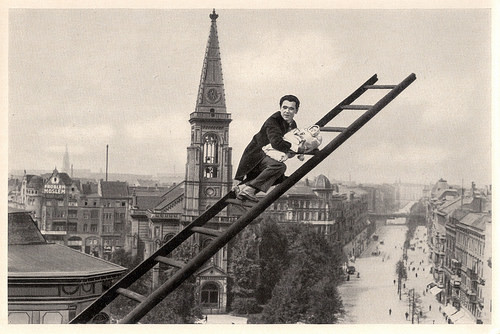
Vintage collectors card from the German album Vom Werden Deutscher Filmkunst, I (Oskar Kalbus, 1935). Photo: Luciano Albertini in the German silent film Der Mann auf dem Kometen (Alfred Halm, 1925).
Der Mann auf dem Kometen is set in Berlin and this image combines two moments in the film. Towards the end of the film Luciano uses a ladder to save a baby put on an old factory chimney pipe which is about to be exploded. The background of this picture is used for another scene in the film. The church is a typical example of Wilhelminian architecture, the site may be somewhere in the old Stadmitte of Berlin where most Albertini films were shot when filmed in Berlin. The sign of Problem Moslem refers to a cigarette brand.
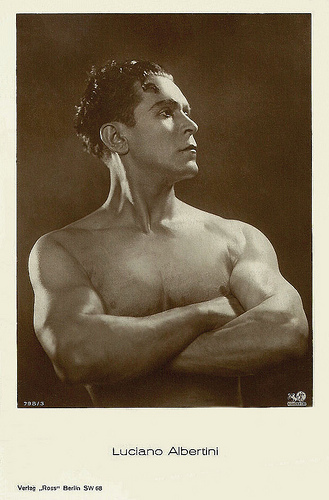
German postcard by Ross Verlag, no. 798/3, 1925-1926. Photo: Phoebus Film, Berlin.
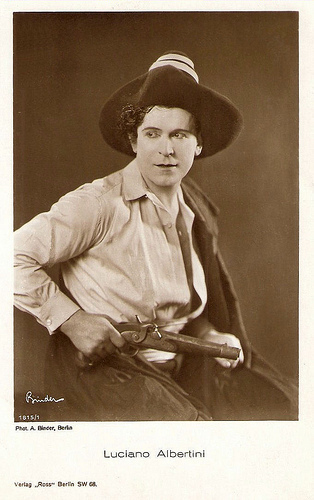
German postcard by Ross Verlag, no. 1815/1, 1927-1928. Photo: Alex Binder, Berlin. On this postcard Albertini wears the attire for the film Rinaldo Rinaldini (Max Obal, 1927).
Flying Trapeze
Luciano Albertini was born as Francesco Vespignani in Lugo di Romagna, Italy, in 1882. In his youth, he already showed a passion for sports, joining the gymnastics club in Forlí and later in Bologna. After his studies he ended up in France, where he retook his lessons in physical exercise at the Ecole Péchin in Lyon.
He entered the Circus Busch and in 1905 he married circus artist Domenica Meirone in Marseille. He took the stage name of Luciano Albertini and created a number on the flying trapeze with 8 persons: Les Albertini. His speciality was a stunt, the ‘death spiral’.
When he returned to Italy, he started his film career in historical epics as Spartaco/Spartacus (Giovanni Enrico Vidali, 1913). At IMDb , Michael Elliott reviews: "The second adaptation of Raffaello Giovagnoli's novel comes at a time when Italy really started pumping out their epic films with the longer running times, expensive sets and lavish production values. This film really doesn't stray too far from the source as we have our hero Spartacus being sold as a slave only to rise up and battle the evil Crassus. These Italian movies are certainly a far cry from the American ones coming out at the same time and this one here has so much going for it that I'm sure even the most jaded silent-hater would have to respect what's on display here."
Albertini also appeared opposite film diva Francesca Bertina in Assunta Spina (Francesca Bertini, Gustavo Serena, 1915). The First World War broke out and Albertini joined the navy. He still kept one foot to the ground though, and he worked at the film company Società Anonima Ambrosio of Turin.
His breakthrough was the circus film La spirale della morte/The Death Spiral (Filippo Castamagna, Domenico Gambino, 1917). Afterwards he worked for the studios Pasquali and Latina Ars, both also in Turin. At Pasquali he started the successful Sansone (Samson) series, with Sansone contro i Filistei/Sansone Against the Philistines (Domenico Gaido, 1918).
Luciano Albertini's finest moment came when he founded his own company Albertini Film, that released its first films in 1919. Until 1921 Albertini Film produced three series: the Sansone films, the Lilliput series with the children Arnold (Patata) and Varada (they were not Albertini’s children although the promotion pretended so), and the Sansonette series with Linda Albertini, his so-called wife, but her true identity remains a mystery. Albertini also produced Il mostro di Frankenstein/The Monster of Frankenstein (Eugenio Testa, 1920), in which he himself personified Baron Frankenstein.
His best Italian film was not one of his Sansone films but the costume drama Il Ponte dei Sospiri/The Bridge of Sighs (Domenico Gaido, 1921), a swashbuckler set in Venice. Albertini played Rolando Candiani, son of the Doge of Venice, who is falsely accused of murder by his enemies. One plots to become Doge himself, another wants to steal the beautiful Leonora, Rolando's fiancée, a third is a courtesan rejected by Rolando. On the day of his marriage Rolando is arrested, trialled and passes the Bridge of Sighs before entering lifetime imprisonment. His father is dethroned as Doge, blinded and reduced to a wandering beggar. But with the help of the courageous and good-hearted bandit Scalabrino (Garaveo Onorato), Rolando manages to escape and take revenge...
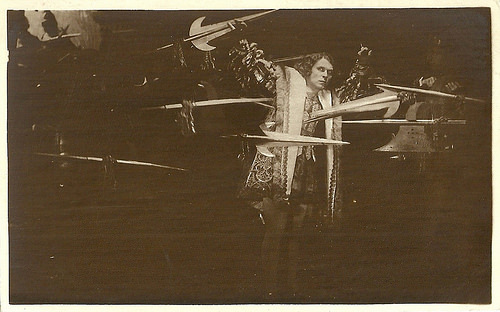
Italian postcard by Unione Cinematografica Italiana. Postcard for the four-part serial Il Ponte dei Sospiri/The Bridge of Sighs (Domenico Gaido, 1921), starring Luciano Albertini, and set in Venice. Caption: The young and very brave son of Doge Candiano, Rolando, is pushed into prison by halberds.
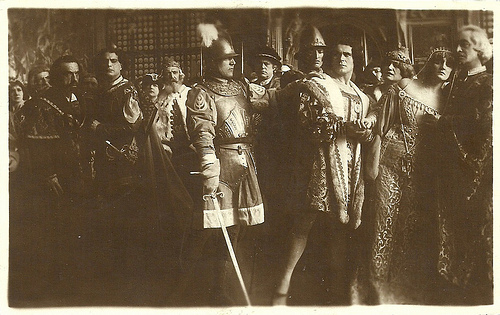
Italian postcard by Unione Cinematografica Italiana. Luciano Albertini as Rolando in the four part serial film Il ponte dei sospiri/The Bridge of Sighs (Domenico Gaido, 1921). On his right side Carolina White (Leonora) and Bonaventura Ibanez (her father Dandolo).
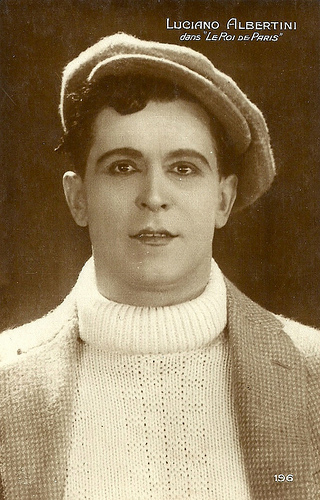
French postcard by Editions Cinémagazine, no. 196. Photo: Luciano Albertini in Julot, der Apache/Julot, the Apache (Joseph Delmont, Hertha von Walther, 1921), released in France as Julot l'apache but also as Le roi de Paris.
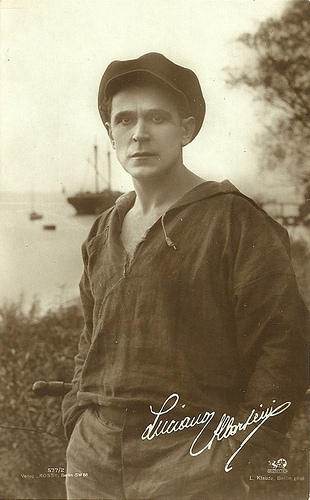
German postcard by Ross Verlag, no. 577/2. Photo L. Klaude, Berlin /Phoebus Film. From his arrival in 1921, until 1924, all of Albertini's films were distributed by Phoebus and produced by his own Albertini-Film. This is a card for Die Schlucht des Todes/The Ravine of Death (Luciano Albertini, Albert-Francis Bertoni, Max Obal, 1923).
In this film Albertini plays an Argentine farmer whose reckless deeds at the Devil's Canyon convinces an Italian circus director to engage him and his wife ( Lya de Putti ). The wife becomes enamoured with a womanizing count and elopes with him. Years after, Luciano has become a dockworker in Naples (as depicted on this card) and saves a child, unknowing it is the child of Lya's and the count. The count is fed up with Lya. She runs into Luciano and begs him to go back with her to Argentine. Back there he finds out she has a child and recognizes it as the girl he once saved. Galloping towards the Devil's Canyon, his horse is cleverer than he and holds back. Lya gallops behind him but she falls down a cliff, so Luciano rescues her and they reunite.
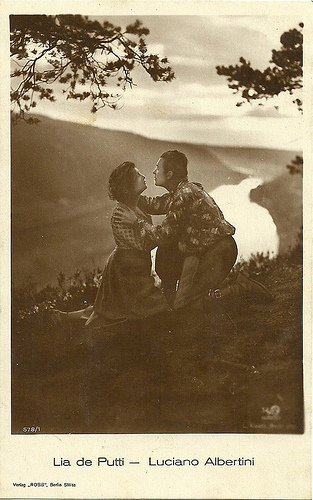
German postcard by Ross Verlag, no. 578/1, 1919-1924. Photo: Leo Klaude, Berlin / Phoebus Film. Publicity still for Die Schlucht des Todes/The Ravine of Death (Luciano Albertini, Albert-Francis Bertoni, Max Obal, 1923) with Lya de Putti . The card depicts the final scene: Luciano has just saved Lya from falling down the Devil's Canyon and reconciles with her after his refusal to acknowledge her illegal child and his failed attempt to suicide.
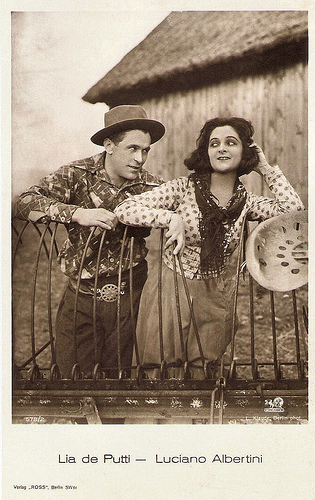
German postcard by Ross Verlag, no. 578/2, 1919-1924. Photo: Leo Klaude, Berlin / Phoebus Film. Publicity still for Die Schlucht des Todes/The Ravine of Death (Luciano Albertini, Albert-Francis Bertoni, Max Obal, 1923) with Lya de Putti .
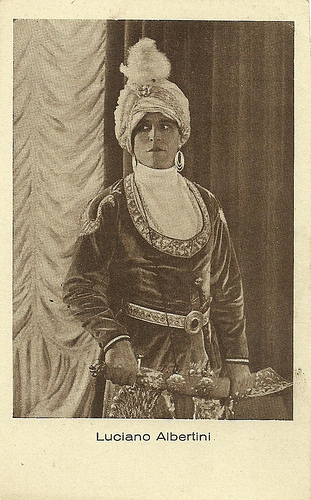
German postcard. Photo: Luciano Albertini in Der Sieg des Maharadscha/The victory of the Maharajah (Joseph Delmont, 1923).
Berlin Entourage
The crisis in the Italian cinema forced Luciano Albertini and his Albertini Film to move to Germany in 1921. They were well received by producer Jacob Karol, who specialized in adventure and circus films. Their first film was Der König der Manege/The King of the Circus Ring (Joseph Delmont. 1921). He continued with a series of films directed by Delmont and produced by himself: Der eiserne Faust/The Iron Fist (1921), Julot der Apache/Julot the Apache (1921), Der Todesleiter/The Death Ladder (1921), and Der Man aus Stahl/The Steel Man (1922).
Albertini-Film became part of the new production and distribution company Phoebus-Film till 1924. Phoebus also owned two major cinemas in Berlin and specialized in hosting Italian directors and actors, such as Gennaro Righelli, Nunzio Malasomma and Carlo Aldini .
Linda Albertini returned to Italy after one year and four films, because Luciano had an affair with another woman. Within his Berlin entourage remained his regular cameraman Eduardo Lamberti and Angelo Rossi, who worked as his double but also as the double of such other Italian ‘giants’ working in Germany as Carlo Aldini and Domenico Gambino . Matias Bleckmann writes in his book on Harry Piel , that Piel's stuntman Hermann Stetza also worked for Albertini as a double.
Albertini starred in popular German films directed by Nunzio Malasomma – another Italian immigrant working in Berlin - and Max Obal. Albertini also directed and produced himself once in Die Schlucht des Todes/The Ravine of Death (Luciano Albertini, Albert-Francis Bertoni, Max Obal, 1923) opposite vamp Lya de Putti . With Nunzio Malasomma, Albertini did Mister Radio (1924), Der König und die kleine Mädchen/The King and the Little Girls (1925), and Eine Minute vor 12/One Minute to Twelve (1925).
Max Obal directed the most Albertini films: Die heimkehr des Odysseus/The Return of Odysseus (1922), Rinaldo Rinaldini (1927) starring opposite Hans Albers , Der grösste Gauner des Jahrhunderts/The Biggest Crook of the Century (1927), Der Unüberwindliche/The Invincible (1928) with Vivian Gibson , Tempo! Tempo! (1929) with Hilda Rosch , and Jagd nach der Million/The Hunt for a Million (1930) with Gretl Berndt. Most of Albertini's later films were distributed by Aafa-Film. According to some sources, Albertini also appeared in the Soviet classic Arsenal/January Uprising in Kiev (Aleksandr Dovzhenko, 1928). But this is probably a fable.
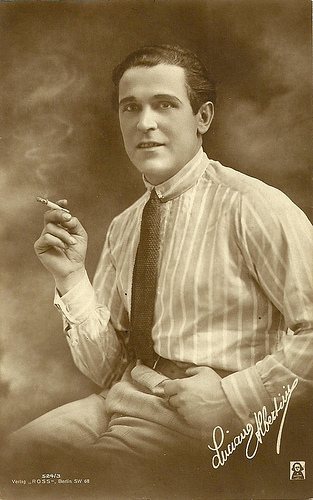
German postcard by Ross Verlag, Berlin SW, no. 524/3.
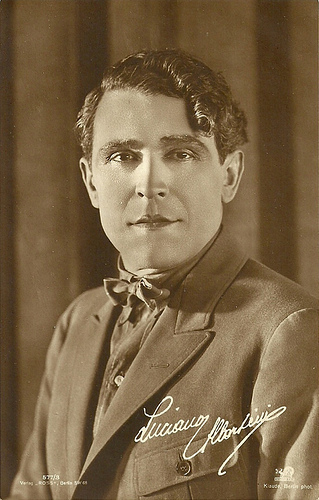
German postcard by Ross Verlag, Berlin, no. 577/8. Photo Krause, Berlin / Phoebus Film.
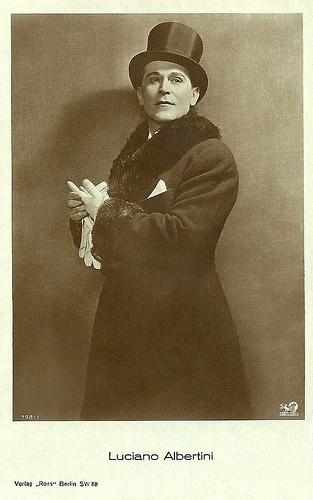
German postcard by Ross Verlag, Berlin, no. 798/1, 1925-1926. Collection: Didier Hanson.
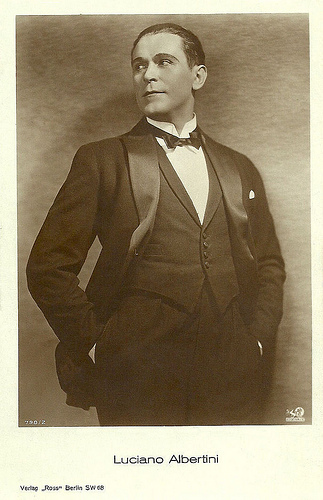
German postcard by Ross Verlag, Berlin, no. 798/2, 1925-1926. Photo: Phoebus Film, Berlin. Collection: Didier Hanson.
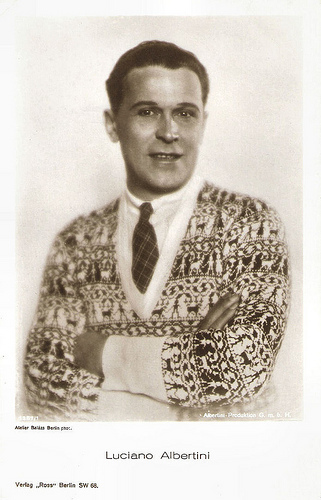
German postcard by Ross Verlag, no. 1287/1, 1927-1928. Photo: Atelier Balazs, Berlin / Albertini-Produktion GmbH.
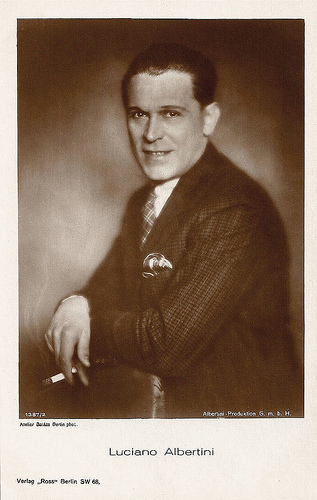
German postcard by Ross Verlag, no. 1387/2, 1927-1928. Photo: Atelier Balazs, Berlin / Albertini Produktion GmbH.
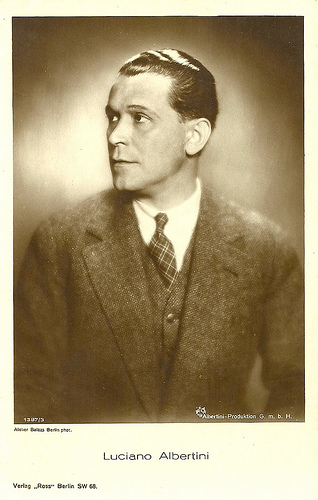
German postcard by Ross Verlag, no. 1387/3, 1927-1928. Photo: Atelier Balazs, Berlin / Albertini Produktion GmbH.
Asylum
In Berlin, Luciano Albertini lived in grand style, visiting restaurants with his friends and crew. He lived in a villa in the outskirts, in the workman’s quarter Siemensstadt. Albertini had several affairs in Berlin, including one with actress Annie Gorilowa. At the Sportpalast, he and Marlene Dietrich were the big attractions.
His only setback had been his collaboration with Universal Studios to the American 15 part-serial The Iron Man (Jay Marchant, 1924), as he proved not to be the protagonist. Instead he had been forced to jump from the Brooklyn Bridge to a race boat, while he often had his stuntmen doing this.
In 1930, the tide changed for Albertini. The talkies, his age (he was 50 now), the saturation of the acrobatic genre contributed, but his alcoholism really finished him. Although Angelo Rossi, his double, and Lamberti, his ex-cameraman who had opened a restaurant in the Friedrichstrasse, helped him, Albertini went down all the way. He performed in one last film: Es geht um alle/It Involves Everything (Max Nosseck, 1932) with Ernö Verebes.
When he showed aggression against a doorman he was put in an asylum and was diagnosed with dementia. In the late 1930s he returned to Italy, living in Bologna where a Father Marella took care of him.
His disease lead him to Villa Flora in Bologna and finally to the mental asylum San Gaetano in Budrio near Bologna. Luciano Albertini died here, in 1945.
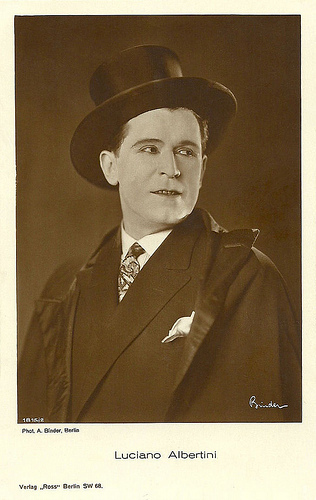
German postcard by Ross Verlag, Berlin, no. 1816/2, 1927-1928. Photo: Alex Binder. Collection: Didier Hanson.
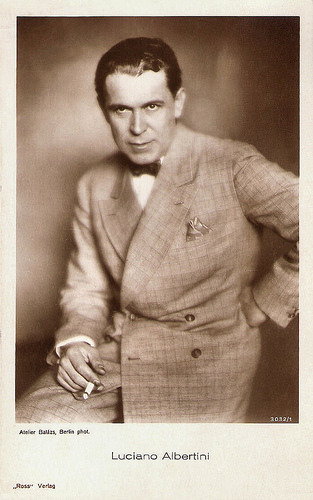
German postcard by Ross Verlag, no. 3032/1, 1928-1929. Photo: Atelier Balázs, Berlin. This picture was also used for the cover of the magazine Film-Woche, no. 17, 1929, to announce Albertini's film Tempo! Tempo! (Max Obal, 1929).
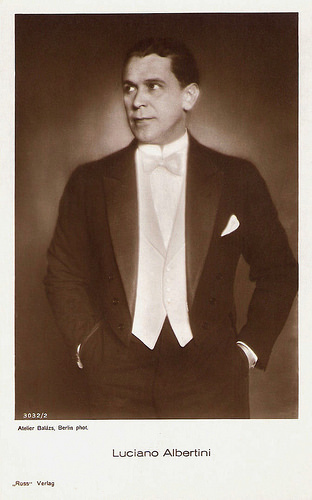
German postcard by Ross Verlag, no. 3032/2, 1928-1929. Photo: Atelier Balázs, Berlin.
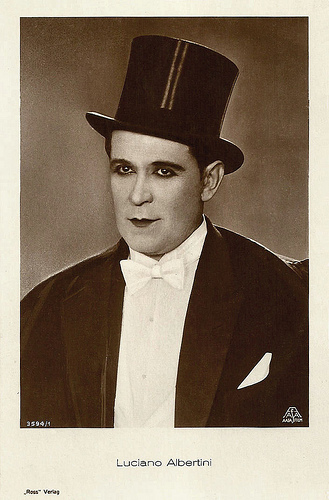
German postcard by Ross Verlag, no. 3594/1, 1928-1929. Photo: Aafa Film.
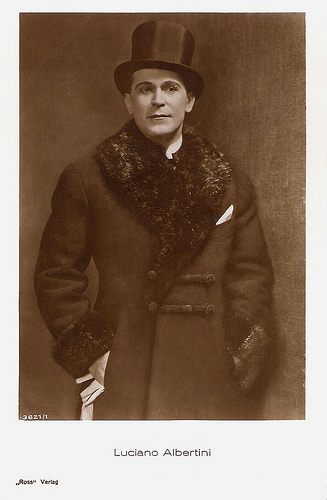
German postcard by Ross Verlag, no. 3621/1, 1928-1929.
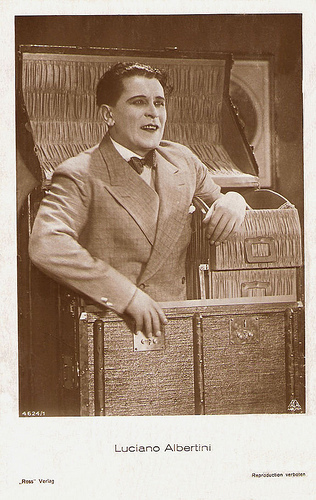
German postcard by Ross Verlag, no. 4624/1, 1929-1930. Photo: Aafa-Film.
Sources: Vittorio Martinelli/Mario Quargnolo (Maciste & Co. I giganti buoni del muto italiano), Matias Bleckmann (Harry Piel. Ein Kino-Mythos und seine Zeit - German), Thomas Staedeli (Cyranos), Michael Elliott (IMDb), (IMDb), Wikipedia (German) and .

American postcard by A.G.F. Photo: Photocine.

German postcard by Ross Verlag, Berlin, no. 524/4, 1919-1924. Collection: Didier Hanson.

German postcard by Ross Verlag, no. 577/1, 1919-1924. Photo: Klaude, Berlin / Phoebus-Film. Publicity still for Der Sieg des Maharadscha/The victory of the Maharajah (Joseph Delmont, 1923).

Vintage collectors card from the German album Vom Werden Deutscher Filmkunst, I (Oskar Kalbus, 1935). Photo: Luciano Albertini in the German silent film Der Mann auf dem Kometen (Alfred Halm, 1925).
Der Mann auf dem Kometen is set in Berlin and this image combines two moments in the film. Towards the end of the film Luciano uses a ladder to save a baby put on an old factory chimney pipe which is about to be exploded. The background of this picture is used for another scene in the film. The church is a typical example of Wilhelminian architecture, the site may be somewhere in the old Stadmitte of Berlin where most Albertini films were shot when filmed in Berlin. The sign of Problem Moslem refers to a cigarette brand.

German postcard by Ross Verlag, no. 798/3, 1925-1926. Photo: Phoebus Film, Berlin.

German postcard by Ross Verlag, no. 1815/1, 1927-1928. Photo: Alex Binder, Berlin. On this postcard Albertini wears the attire for the film Rinaldo Rinaldini (Max Obal, 1927).
Flying Trapeze
Luciano Albertini was born as Francesco Vespignani in Lugo di Romagna, Italy, in 1882. In his youth, he already showed a passion for sports, joining the gymnastics club in Forlí and later in Bologna. After his studies he ended up in France, where he retook his lessons in physical exercise at the Ecole Péchin in Lyon.
He entered the Circus Busch and in 1905 he married circus artist Domenica Meirone in Marseille. He took the stage name of Luciano Albertini and created a number on the flying trapeze with 8 persons: Les Albertini. His speciality was a stunt, the ‘death spiral’.
When he returned to Italy, he started his film career in historical epics as Spartaco/Spartacus (Giovanni Enrico Vidali, 1913). At IMDb , Michael Elliott reviews: "The second adaptation of Raffaello Giovagnoli's novel comes at a time when Italy really started pumping out their epic films with the longer running times, expensive sets and lavish production values. This film really doesn't stray too far from the source as we have our hero Spartacus being sold as a slave only to rise up and battle the evil Crassus. These Italian movies are certainly a far cry from the American ones coming out at the same time and this one here has so much going for it that I'm sure even the most jaded silent-hater would have to respect what's on display here."
Albertini also appeared opposite film diva Francesca Bertina in Assunta Spina (Francesca Bertini, Gustavo Serena, 1915). The First World War broke out and Albertini joined the navy. He still kept one foot to the ground though, and he worked at the film company Società Anonima Ambrosio of Turin.
His breakthrough was the circus film La spirale della morte/The Death Spiral (Filippo Castamagna, Domenico Gambino, 1917). Afterwards he worked for the studios Pasquali and Latina Ars, both also in Turin. At Pasquali he started the successful Sansone (Samson) series, with Sansone contro i Filistei/Sansone Against the Philistines (Domenico Gaido, 1918).
Luciano Albertini's finest moment came when he founded his own company Albertini Film, that released its first films in 1919. Until 1921 Albertini Film produced three series: the Sansone films, the Lilliput series with the children Arnold (Patata) and Varada (they were not Albertini’s children although the promotion pretended so), and the Sansonette series with Linda Albertini, his so-called wife, but her true identity remains a mystery. Albertini also produced Il mostro di Frankenstein/The Monster of Frankenstein (Eugenio Testa, 1920), in which he himself personified Baron Frankenstein.
His best Italian film was not one of his Sansone films but the costume drama Il Ponte dei Sospiri/The Bridge of Sighs (Domenico Gaido, 1921), a swashbuckler set in Venice. Albertini played Rolando Candiani, son of the Doge of Venice, who is falsely accused of murder by his enemies. One plots to become Doge himself, another wants to steal the beautiful Leonora, Rolando's fiancée, a third is a courtesan rejected by Rolando. On the day of his marriage Rolando is arrested, trialled and passes the Bridge of Sighs before entering lifetime imprisonment. His father is dethroned as Doge, blinded and reduced to a wandering beggar. But with the help of the courageous and good-hearted bandit Scalabrino (Garaveo Onorato), Rolando manages to escape and take revenge...

Italian postcard by Unione Cinematografica Italiana. Postcard for the four-part serial Il Ponte dei Sospiri/The Bridge of Sighs (Domenico Gaido, 1921), starring Luciano Albertini, and set in Venice. Caption: The young and very brave son of Doge Candiano, Rolando, is pushed into prison by halberds.

Italian postcard by Unione Cinematografica Italiana. Luciano Albertini as Rolando in the four part serial film Il ponte dei sospiri/The Bridge of Sighs (Domenico Gaido, 1921). On his right side Carolina White (Leonora) and Bonaventura Ibanez (her father Dandolo).

French postcard by Editions Cinémagazine, no. 196. Photo: Luciano Albertini in Julot, der Apache/Julot, the Apache (Joseph Delmont, Hertha von Walther, 1921), released in France as Julot l'apache but also as Le roi de Paris.

German postcard by Ross Verlag, no. 577/2. Photo L. Klaude, Berlin /Phoebus Film. From his arrival in 1921, until 1924, all of Albertini's films were distributed by Phoebus and produced by his own Albertini-Film. This is a card for Die Schlucht des Todes/The Ravine of Death (Luciano Albertini, Albert-Francis Bertoni, Max Obal, 1923).
In this film Albertini plays an Argentine farmer whose reckless deeds at the Devil's Canyon convinces an Italian circus director to engage him and his wife ( Lya de Putti ). The wife becomes enamoured with a womanizing count and elopes with him. Years after, Luciano has become a dockworker in Naples (as depicted on this card) and saves a child, unknowing it is the child of Lya's and the count. The count is fed up with Lya. She runs into Luciano and begs him to go back with her to Argentine. Back there he finds out she has a child and recognizes it as the girl he once saved. Galloping towards the Devil's Canyon, his horse is cleverer than he and holds back. Lya gallops behind him but she falls down a cliff, so Luciano rescues her and they reunite.

German postcard by Ross Verlag, no. 578/1, 1919-1924. Photo: Leo Klaude, Berlin / Phoebus Film. Publicity still for Die Schlucht des Todes/The Ravine of Death (Luciano Albertini, Albert-Francis Bertoni, Max Obal, 1923) with Lya de Putti . The card depicts the final scene: Luciano has just saved Lya from falling down the Devil's Canyon and reconciles with her after his refusal to acknowledge her illegal child and his failed attempt to suicide.

German postcard by Ross Verlag, no. 578/2, 1919-1924. Photo: Leo Klaude, Berlin / Phoebus Film. Publicity still for Die Schlucht des Todes/The Ravine of Death (Luciano Albertini, Albert-Francis Bertoni, Max Obal, 1923) with Lya de Putti .

German postcard. Photo: Luciano Albertini in Der Sieg des Maharadscha/The victory of the Maharajah (Joseph Delmont, 1923).
Berlin Entourage
The crisis in the Italian cinema forced Luciano Albertini and his Albertini Film to move to Germany in 1921. They were well received by producer Jacob Karol, who specialized in adventure and circus films. Their first film was Der König der Manege/The King of the Circus Ring (Joseph Delmont. 1921). He continued with a series of films directed by Delmont and produced by himself: Der eiserne Faust/The Iron Fist (1921), Julot der Apache/Julot the Apache (1921), Der Todesleiter/The Death Ladder (1921), and Der Man aus Stahl/The Steel Man (1922).
Albertini-Film became part of the new production and distribution company Phoebus-Film till 1924. Phoebus also owned two major cinemas in Berlin and specialized in hosting Italian directors and actors, such as Gennaro Righelli, Nunzio Malasomma and Carlo Aldini .
Linda Albertini returned to Italy after one year and four films, because Luciano had an affair with another woman. Within his Berlin entourage remained his regular cameraman Eduardo Lamberti and Angelo Rossi, who worked as his double but also as the double of such other Italian ‘giants’ working in Germany as Carlo Aldini and Domenico Gambino . Matias Bleckmann writes in his book on Harry Piel , that Piel's stuntman Hermann Stetza also worked for Albertini as a double.
Albertini starred in popular German films directed by Nunzio Malasomma – another Italian immigrant working in Berlin - and Max Obal. Albertini also directed and produced himself once in Die Schlucht des Todes/The Ravine of Death (Luciano Albertini, Albert-Francis Bertoni, Max Obal, 1923) opposite vamp Lya de Putti . With Nunzio Malasomma, Albertini did Mister Radio (1924), Der König und die kleine Mädchen/The King and the Little Girls (1925), and Eine Minute vor 12/One Minute to Twelve (1925).
Max Obal directed the most Albertini films: Die heimkehr des Odysseus/The Return of Odysseus (1922), Rinaldo Rinaldini (1927) starring opposite Hans Albers , Der grösste Gauner des Jahrhunderts/The Biggest Crook of the Century (1927), Der Unüberwindliche/The Invincible (1928) with Vivian Gibson , Tempo! Tempo! (1929) with Hilda Rosch , and Jagd nach der Million/The Hunt for a Million (1930) with Gretl Berndt. Most of Albertini's later films were distributed by Aafa-Film. According to some sources, Albertini also appeared in the Soviet classic Arsenal/January Uprising in Kiev (Aleksandr Dovzhenko, 1928). But this is probably a fable.

German postcard by Ross Verlag, Berlin SW, no. 524/3.

German postcard by Ross Verlag, Berlin, no. 577/8. Photo Krause, Berlin / Phoebus Film.

German postcard by Ross Verlag, Berlin, no. 798/1, 1925-1926. Collection: Didier Hanson.

German postcard by Ross Verlag, Berlin, no. 798/2, 1925-1926. Photo: Phoebus Film, Berlin. Collection: Didier Hanson.

German postcard by Ross Verlag, no. 1287/1, 1927-1928. Photo: Atelier Balazs, Berlin / Albertini-Produktion GmbH.

German postcard by Ross Verlag, no. 1387/2, 1927-1928. Photo: Atelier Balazs, Berlin / Albertini Produktion GmbH.

German postcard by Ross Verlag, no. 1387/3, 1927-1928. Photo: Atelier Balazs, Berlin / Albertini Produktion GmbH.
Asylum
In Berlin, Luciano Albertini lived in grand style, visiting restaurants with his friends and crew. He lived in a villa in the outskirts, in the workman’s quarter Siemensstadt. Albertini had several affairs in Berlin, including one with actress Annie Gorilowa. At the Sportpalast, he and Marlene Dietrich were the big attractions.
His only setback had been his collaboration with Universal Studios to the American 15 part-serial The Iron Man (Jay Marchant, 1924), as he proved not to be the protagonist. Instead he had been forced to jump from the Brooklyn Bridge to a race boat, while he often had his stuntmen doing this.
In 1930, the tide changed for Albertini. The talkies, his age (he was 50 now), the saturation of the acrobatic genre contributed, but his alcoholism really finished him. Although Angelo Rossi, his double, and Lamberti, his ex-cameraman who had opened a restaurant in the Friedrichstrasse, helped him, Albertini went down all the way. He performed in one last film: Es geht um alle/It Involves Everything (Max Nosseck, 1932) with Ernö Verebes.
When he showed aggression against a doorman he was put in an asylum and was diagnosed with dementia. In the late 1930s he returned to Italy, living in Bologna where a Father Marella took care of him.
His disease lead him to Villa Flora in Bologna and finally to the mental asylum San Gaetano in Budrio near Bologna. Luciano Albertini died here, in 1945.

German postcard by Ross Verlag, Berlin, no. 1816/2, 1927-1928. Photo: Alex Binder. Collection: Didier Hanson.

German postcard by Ross Verlag, no. 3032/1, 1928-1929. Photo: Atelier Balázs, Berlin. This picture was also used for the cover of the magazine Film-Woche, no. 17, 1929, to announce Albertini's film Tempo! Tempo! (Max Obal, 1929).

German postcard by Ross Verlag, no. 3032/2, 1928-1929. Photo: Atelier Balázs, Berlin.

German postcard by Ross Verlag, no. 3594/1, 1928-1929. Photo: Aafa Film.

German postcard by Ross Verlag, no. 3621/1, 1928-1929.

German postcard by Ross Verlag, no. 4624/1, 1929-1930. Photo: Aafa-Film.
Sources: Vittorio Martinelli/Mario Quargnolo (Maciste & Co. I giganti buoni del muto italiano), Matias Bleckmann (Harry Piel. Ein Kino-Mythos und seine Zeit - German), Thomas Staedeli (Cyranos), Michael Elliott (IMDb), (IMDb), Wikipedia (German) and .
Published on October 03, 2015 22:00
October 2, 2015
Bartolomeo Pagano
Today starts the 34th edition of Le Giornate del Cinema Muto in Pordenone. We are in Italy to attend this wonderful festival of the silent film and will post about the stars of the highlights of the festival. Opening film is Maciste alpino/The Warrior (Giovanni Pastrone, 1916) in which Italian actor Bartolomeo Pagano (1878-1947) stars as Maciste. His name is forever attached to the character of the strong man, which he played in 25 films.
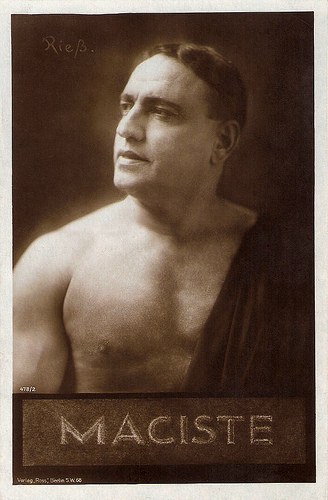
German postcard by Ross Verlag, Berlin, no. 478/2, 1919-1924. Photo: Riess.
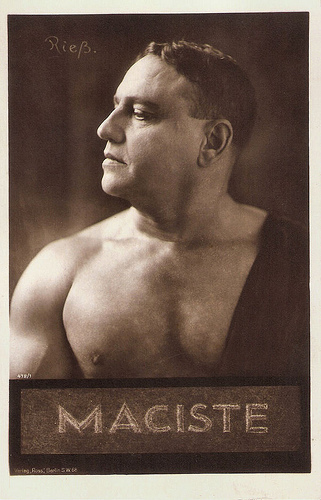
German postcard by Ross Verlag, Berlin, no. 478/1, 1919-1924. Photo: Riess.
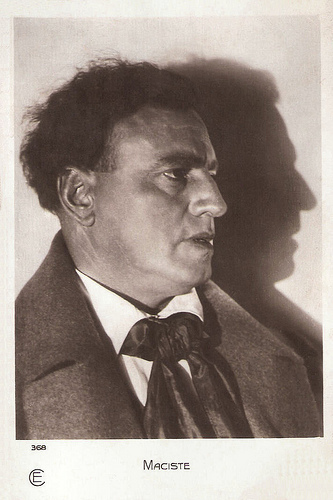
French postcard by Cinémagazine-Edition, no. 368. Bartolomeo Pagano aka Maciste in Maciste all'inferno/Maciste in Hell (Guido Brignone, 1926).
In blackface
Bartolomeo Pagano was born in the Sant’Ilario quarter of Genua in 1878. He was the son of Neapolitan father. As an adult he worked as a dock-hand in the port of Genua, in the nearby quarter of Nervi.
Different versions circulate about his discovery for the cinema. In 1913 film director and producer Giovanni Pastrone, manager of the Itala company of Turin, released a call for the interpreter of the character of the Nubic slave Maciste (a character created together with author Gabriele D’Annunzio) for Pastrone’s super-production Cabiria (Giovanni Pastrone, 1914) starring diva Italia Almirante-Manzini . Out of 50 candidates from all over Italy, Pastrone selected Pagano.
According to another version, it was actor Domenico Gambino who noticed Pagano and signalled him to Pastrone, who, impressed by his muscular physique, hired him for his epic film. Overnight the film made Pagano an international success because of his muscles and his image as a courageous, humorous and no-nonsensical defender of the weak. In Cabiria he uses his power to rescue a Roman girl out of the hands of the Carthaginian priests who want to offer her to Moloch.
Pastrone immediately saw opportunities with his new star and launched a series of vehicles for his character, starting with a film simply called Maciste (Luigi Romano Borgnetto, Vincenzo Denizot, 1915). Deliberately, Maciste’s part in Cabiria, the splendour of the Itala studio, and Maciste’s work there, were shown to impress audiences and tie them to the previous box office hit. Of course the plot deals with a damsel in distress, whom Maciste saves with his muscles and his wit.
During the First World War, Pastrone used Maciste for war propaganda in Maciste alpino/The Warrior (Giovanni Pastrone, 1916), in which Maciste fiercely opposes the Austrian soldiers when he and his colleagues are captured during a film shoot on location. The success of the film made Pastrone exploit Maciste in all kinds of situations and genres, but mostly in the adventure and crime genre: Maciste medium (Vincenzo Denizot, 1918), Maciste atleta/Maciste Athlete (Vincenzo Denizot, Giovanni Pastrone, 1918), Maciste poliziotto (Roberto Roberti, 1918), Maciste innamorato/Maciste in Love (Luigi Romano Borgnetto, 1919), La trilogia di Maciste/The Maciste Trilogy (Carlo Campogalliani, 1920), Maciste salvato dalle acque/Maciste saved from the waters (Luigi Romano Borgnetto, 1921), and Maciste in vacanza/Maciste on holiday (Luigi Romano Borgnetto, 1921).
In all these films he performed Maciste in 'blackface', which he continued to do in all 25 films in which he played Maciste. By now Pastrone did not direct the films anymore but left this task to skilled directors like Luigi Romano Borgnetto. While not all of these were good productions, La Trilogia di Maciste (1920) by Carlo Campogalliani was one of the better Maciste films.
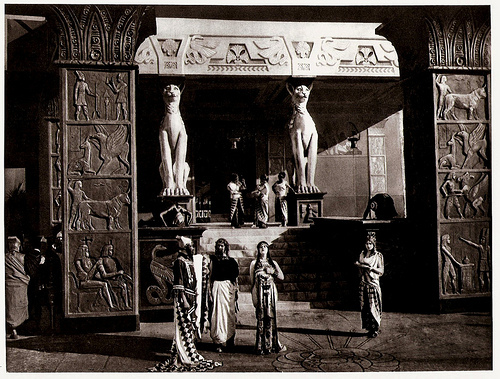
Publicity still of the Italian silent film classic Cabiria (Giovanni Pastrone 1914), with Alex Bernard, Edoardo Davesnes, Italia Almirante-Manzini and Lydia Quaranta .
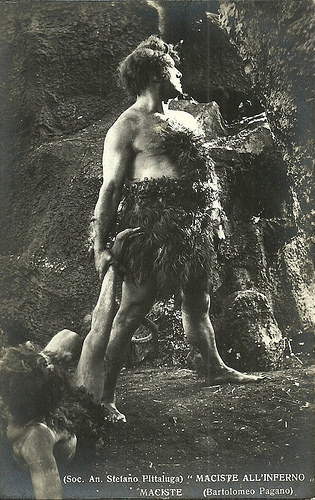
Italian postcard by Ed. A. Traldi, Milano. Photo: Dist. Società Anonima Stefano Pittaluga. Publicity still of Bartolomeo Pagano as Maciste in Maciste all'inferno/Maciste in Hell (Guido Brignone, 1926).
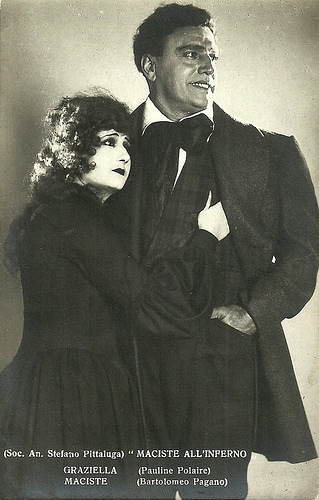
Italian postcard by Ed. A. Traldi, Milano. Photo: Pittaluga Films, Torino. Publicity still for the Italian silent film Maciste all'inferno (Guido Brignone, 1926), starring Bartolomeo Pagano as Maciste and Pauline Polaire as Graziella.
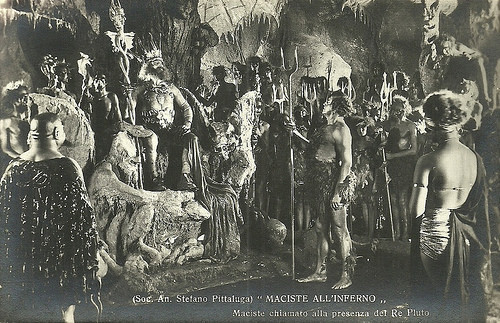
Italian postcard by Ed. A. Traldi, Milano. Photo: Pittaluga Films, Torino. Publicity still for Maciste all'inferno/Maciste in Hell (Guido Brignone 1926). Caption: Maciste (Bartolomeo Pagano) called before king Pluto (Umberto Guarracino). On the right on the back Pluto's daughter Luciferina (Lucia Zanussi) is standing. The bold guy on the left must be Gerione (Mario Saio).
Strong Men of Forzuti
While Bartolomeo Pagano’s precursor Bruto Castellani , the strong man Ursus in Quo vadis (Enrico Guazzoni, 1913), had no followers, Pagano’s Maciste did.
In Italy a strong men or forzuti genre in film sprang up, creating space for characters such as Ausonia, Galaor, Ajax, and Sansone, and attracting competing strong men and physical culture champions such as Giovanni Raicevich.
But Pagano’s Maciste was also simply pirated abroad, such as by the French actor Michel Bonnet with his character Magiste, and there was another rip-off in Mexico.
French critic Louis Delluc called him the 'Guitry of biceps', while newcomers Ultus ( Aurele Sydney ) and Douglas Fairbanks were launched as the British and the American Maciste.
In the late 1910s and early 1920s Maciste’s popularity was the biggest in Austria and Germany, despite the preceding anti-Austrian Maciste alpino/The Warrior (1916). At home in Italy, Maciste’s image of superman coincided with the new fascist ideology. In the 1920s Pagano was one of the best paid actors of his times, sometimes gaining 600.000 lire a year.
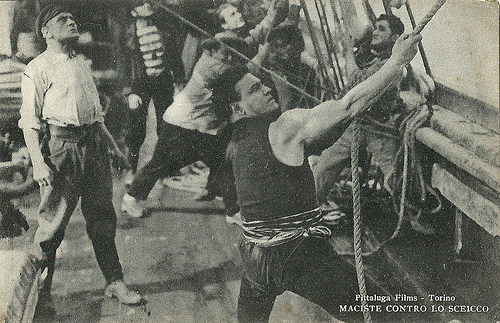
Italian postcard. Photo: Pittaluga Films, Torino (Turin). Publicity still for the Italian silent film Maciste contro lo sceicco/Maciste Against the Sheik (Mario Camerini, 1926). Maciste (Bartolomeo Pagano) hoists the sails, while the evil captain (Alex Bernard) looks on.
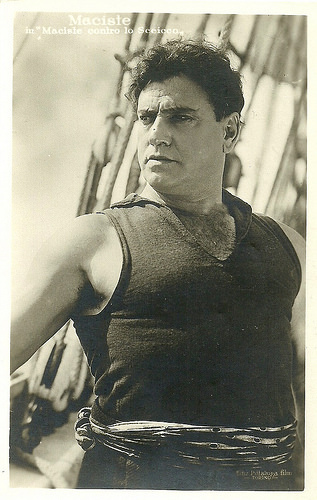
Italian postcard. Maciste (Bartolomeo Pagano) in Maciste contro lo sceicco/Maciste against the Sheik (Mario Camerini, 1926), produced by Pittaluga Film, Turin.
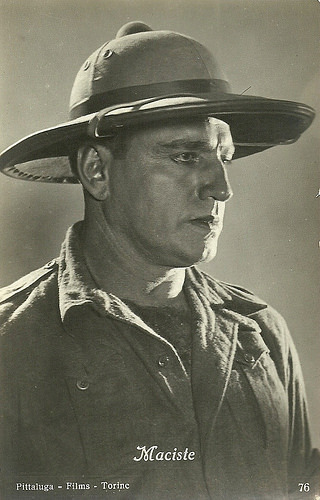
Italian postcard by Ed. A. Traldi, Milano, no. 76. Photo: Pittaluga Films, Torino. Publicity still for Maciste nella gabbia dei leoni/Maciste in the Lion's cage (Guido Brignone, 1926), starring Bartolomeo Pagano as Maciste.
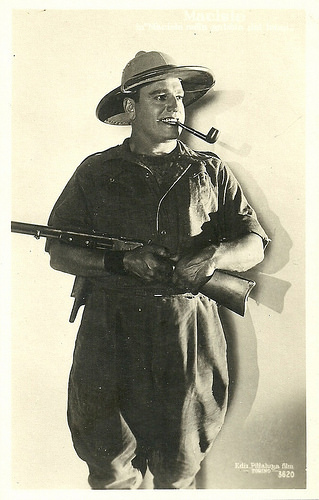
Italian postcard. Photo: Maciste (Bartolomeo Pagano) in Maciste nella gabbia dei leoni/Maciste in the Lion's cage (Guido Brignone, 1926), produced by Pittaluga Film, Turin.
Inspiring Federico Fellini
Bartolomeo Pagano continued to star in the Maciste-films until the early-1920s, when, not so much because of the collapse of the Italian film production but rather because of a fabulous contract, Pagano went to Berlin, the mecca of the European film industry.
Here he stayed between 1921 and 1923, but according to the film press he wasn’t as successful there, playing in Maciste und die Japanerin/Maciste and the Japanese Woman (Uwe Jenss Kraft, 1921) with Carola Toelle , Maciste und die Tochter des Silberkönig/Maciste and the Daughter of the Silver King (Luigi Romano Borgnetto, 1921) opposite Helena Makowska , Maciste und der Sträfling Nr. 51/Maciste and the convict No. 51 (Luigi Romano Borgnetto, 1921), and Maciste und die Chinesische Truhe/Maciste and the Chinese chest (Carl Boese, 1923e).
Dissatisfied Pagano returned to Italy, where producer Stefano Pittaluga immediately put him on a transatlantic for the film Maciste e il nipote d’America/Maciste and the grandson of America (Eleuterio Rodolfi, 1924), which included scenes shot in New York. Among the less convincing titles is Maciste imperatore/Maciste Emperor (Guido Brignone, 1924).
The same year Brignone directed Pagano in Maciste all’Inferno/Maciste in Hell (1926), a witty and artful pastiche on Dante, Gustave Doré, Georges Méliès, Expressionism and medieval illustrations. It also contains ingenious special effects by ‘magician’ Segundo de Chomon. When entering Hades, Maciste is being seduced by Proserpina, played by Italian diva Elena Sagro , and he turns into a hairy devil himself. The film was dear to Federico Fellini, because of its weird, fairy-tale-like atmosphere; the film supposedly inspired him to become film director.
Bored with his Maciste films, Pagano asked and got different roles: Il vetturale del Moncenisio/The coachman of the Mont Cenis (Baldassarre Negroni, 1927) with Rina De Liguoro , Giuditta e Oloferne/Judith and Holofernes (Baldassarre Negroni, 1928) starring Jia Ruskaja, and his last part (a secondary one by now) in L’ultimo Zar/The last Tsar (Baldassarre Negroni, 1928).
The actor retired from films in 1926 to marry Camilla Balduzzi and he raised a family in his Villa Maciste in Sant’Ilario Ligure near Genua. Diabetes destroyed his forces, and typhoid reduced his weight in drastic ways, while arthritis even obliged him to spend his last years in a wheelchair. The outside world didn’t know.
Bartolomeo Pagano died of a heart attack in San Ilario Ligure in 1947. According to Italian film historian Vittorio Martinelli, Pagano never was a real actor, but rather the lively personification of a character from popular literature. His character’s name remains as synonym for power and courage. After Pagano's death, the character of Maciste was played by several other actors. In 1960-1965 Maciste was revived in the sword and sandal films with Mark Forrest, Gordon Scott, Ed Fury and other bodybuilders, while in the early 1970s cult director Jesus Franco made two low-budget Maciste-films for French producers.
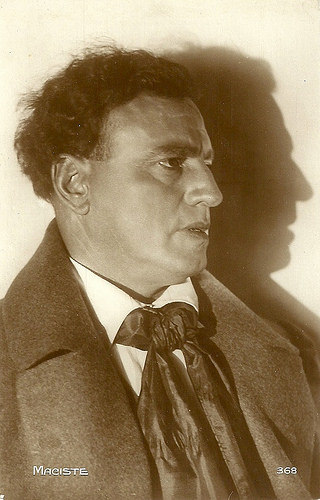
French postcard by Editions Cinémagazine, no. 368. Photo: Bartolomeo Pagano aka Maciste in Maciste all'inferno (Guido Brignone, 1926).
Trailer for Maciste all’Inferno/Maciste in Hell (1926). Source: Comfort Film (YouTube).
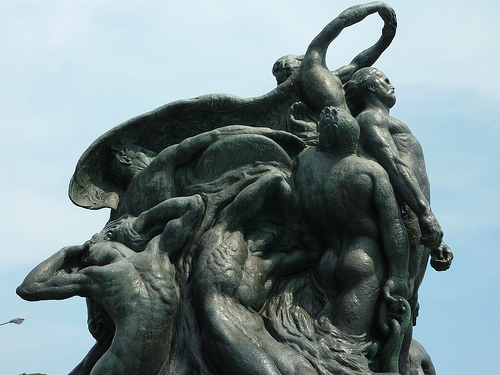
Monumento Quarto dei Mille (1915) by Eugenio Baroni. Near the site of this statue Giuseppe Garibaldi took off to liberate Sicily from the Bourbon regime in 1860, together with his Thousand volunteers. In 1915 the monument was inaugurated with a speech by Gabriele D'Annunzio. Apparently the former Genovese dock worker Bartolomeo Pagano, who had become a major film star as Maciste in Giovanni Pastrone's Cabiria (1914), had modelled for the statue of Garibaldi. So when the statue was revealed audiences whispered that Garibaldi looked a lot like Maciste, their local hero who had become an international star. Quarto or Quarto del mare used to be a separate community but later on became part of the city of Genoa.
Sources: Vittorio Martinelli (Maciste & Co. I giganti buoni del cinema italiano), (IMDb), Wikipedia (Italian and English) and .

German postcard by Ross Verlag, Berlin, no. 478/2, 1919-1924. Photo: Riess.

German postcard by Ross Verlag, Berlin, no. 478/1, 1919-1924. Photo: Riess.

French postcard by Cinémagazine-Edition, no. 368. Bartolomeo Pagano aka Maciste in Maciste all'inferno/Maciste in Hell (Guido Brignone, 1926).
In blackface
Bartolomeo Pagano was born in the Sant’Ilario quarter of Genua in 1878. He was the son of Neapolitan father. As an adult he worked as a dock-hand in the port of Genua, in the nearby quarter of Nervi.
Different versions circulate about his discovery for the cinema. In 1913 film director and producer Giovanni Pastrone, manager of the Itala company of Turin, released a call for the interpreter of the character of the Nubic slave Maciste (a character created together with author Gabriele D’Annunzio) for Pastrone’s super-production Cabiria (Giovanni Pastrone, 1914) starring diva Italia Almirante-Manzini . Out of 50 candidates from all over Italy, Pastrone selected Pagano.
According to another version, it was actor Domenico Gambino who noticed Pagano and signalled him to Pastrone, who, impressed by his muscular physique, hired him for his epic film. Overnight the film made Pagano an international success because of his muscles and his image as a courageous, humorous and no-nonsensical defender of the weak. In Cabiria he uses his power to rescue a Roman girl out of the hands of the Carthaginian priests who want to offer her to Moloch.
Pastrone immediately saw opportunities with his new star and launched a series of vehicles for his character, starting with a film simply called Maciste (Luigi Romano Borgnetto, Vincenzo Denizot, 1915). Deliberately, Maciste’s part in Cabiria, the splendour of the Itala studio, and Maciste’s work there, were shown to impress audiences and tie them to the previous box office hit. Of course the plot deals with a damsel in distress, whom Maciste saves with his muscles and his wit.
During the First World War, Pastrone used Maciste for war propaganda in Maciste alpino/The Warrior (Giovanni Pastrone, 1916), in which Maciste fiercely opposes the Austrian soldiers when he and his colleagues are captured during a film shoot on location. The success of the film made Pastrone exploit Maciste in all kinds of situations and genres, but mostly in the adventure and crime genre: Maciste medium (Vincenzo Denizot, 1918), Maciste atleta/Maciste Athlete (Vincenzo Denizot, Giovanni Pastrone, 1918), Maciste poliziotto (Roberto Roberti, 1918), Maciste innamorato/Maciste in Love (Luigi Romano Borgnetto, 1919), La trilogia di Maciste/The Maciste Trilogy (Carlo Campogalliani, 1920), Maciste salvato dalle acque/Maciste saved from the waters (Luigi Romano Borgnetto, 1921), and Maciste in vacanza/Maciste on holiday (Luigi Romano Borgnetto, 1921).
In all these films he performed Maciste in 'blackface', which he continued to do in all 25 films in which he played Maciste. By now Pastrone did not direct the films anymore but left this task to skilled directors like Luigi Romano Borgnetto. While not all of these were good productions, La Trilogia di Maciste (1920) by Carlo Campogalliani was one of the better Maciste films.

Publicity still of the Italian silent film classic Cabiria (Giovanni Pastrone 1914), with Alex Bernard, Edoardo Davesnes, Italia Almirante-Manzini and Lydia Quaranta .

Italian postcard by Ed. A. Traldi, Milano. Photo: Dist. Società Anonima Stefano Pittaluga. Publicity still of Bartolomeo Pagano as Maciste in Maciste all'inferno/Maciste in Hell (Guido Brignone, 1926).

Italian postcard by Ed. A. Traldi, Milano. Photo: Pittaluga Films, Torino. Publicity still for the Italian silent film Maciste all'inferno (Guido Brignone, 1926), starring Bartolomeo Pagano as Maciste and Pauline Polaire as Graziella.

Italian postcard by Ed. A. Traldi, Milano. Photo: Pittaluga Films, Torino. Publicity still for Maciste all'inferno/Maciste in Hell (Guido Brignone 1926). Caption: Maciste (Bartolomeo Pagano) called before king Pluto (Umberto Guarracino). On the right on the back Pluto's daughter Luciferina (Lucia Zanussi) is standing. The bold guy on the left must be Gerione (Mario Saio).
Strong Men of Forzuti
While Bartolomeo Pagano’s precursor Bruto Castellani , the strong man Ursus in Quo vadis (Enrico Guazzoni, 1913), had no followers, Pagano’s Maciste did.
In Italy a strong men or forzuti genre in film sprang up, creating space for characters such as Ausonia, Galaor, Ajax, and Sansone, and attracting competing strong men and physical culture champions such as Giovanni Raicevich.
But Pagano’s Maciste was also simply pirated abroad, such as by the French actor Michel Bonnet with his character Magiste, and there was another rip-off in Mexico.
French critic Louis Delluc called him the 'Guitry of biceps', while newcomers Ultus ( Aurele Sydney ) and Douglas Fairbanks were launched as the British and the American Maciste.
In the late 1910s and early 1920s Maciste’s popularity was the biggest in Austria and Germany, despite the preceding anti-Austrian Maciste alpino/The Warrior (1916). At home in Italy, Maciste’s image of superman coincided with the new fascist ideology. In the 1920s Pagano was one of the best paid actors of his times, sometimes gaining 600.000 lire a year.

Italian postcard. Photo: Pittaluga Films, Torino (Turin). Publicity still for the Italian silent film Maciste contro lo sceicco/Maciste Against the Sheik (Mario Camerini, 1926). Maciste (Bartolomeo Pagano) hoists the sails, while the evil captain (Alex Bernard) looks on.

Italian postcard. Maciste (Bartolomeo Pagano) in Maciste contro lo sceicco/Maciste against the Sheik (Mario Camerini, 1926), produced by Pittaluga Film, Turin.

Italian postcard by Ed. A. Traldi, Milano, no. 76. Photo: Pittaluga Films, Torino. Publicity still for Maciste nella gabbia dei leoni/Maciste in the Lion's cage (Guido Brignone, 1926), starring Bartolomeo Pagano as Maciste.

Italian postcard. Photo: Maciste (Bartolomeo Pagano) in Maciste nella gabbia dei leoni/Maciste in the Lion's cage (Guido Brignone, 1926), produced by Pittaluga Film, Turin.
Inspiring Federico Fellini
Bartolomeo Pagano continued to star in the Maciste-films until the early-1920s, when, not so much because of the collapse of the Italian film production but rather because of a fabulous contract, Pagano went to Berlin, the mecca of the European film industry.
Here he stayed between 1921 and 1923, but according to the film press he wasn’t as successful there, playing in Maciste und die Japanerin/Maciste and the Japanese Woman (Uwe Jenss Kraft, 1921) with Carola Toelle , Maciste und die Tochter des Silberkönig/Maciste and the Daughter of the Silver King (Luigi Romano Borgnetto, 1921) opposite Helena Makowska , Maciste und der Sträfling Nr. 51/Maciste and the convict No. 51 (Luigi Romano Borgnetto, 1921), and Maciste und die Chinesische Truhe/Maciste and the Chinese chest (Carl Boese, 1923e).
Dissatisfied Pagano returned to Italy, where producer Stefano Pittaluga immediately put him on a transatlantic for the film Maciste e il nipote d’America/Maciste and the grandson of America (Eleuterio Rodolfi, 1924), which included scenes shot in New York. Among the less convincing titles is Maciste imperatore/Maciste Emperor (Guido Brignone, 1924).
The same year Brignone directed Pagano in Maciste all’Inferno/Maciste in Hell (1926), a witty and artful pastiche on Dante, Gustave Doré, Georges Méliès, Expressionism and medieval illustrations. It also contains ingenious special effects by ‘magician’ Segundo de Chomon. When entering Hades, Maciste is being seduced by Proserpina, played by Italian diva Elena Sagro , and he turns into a hairy devil himself. The film was dear to Federico Fellini, because of its weird, fairy-tale-like atmosphere; the film supposedly inspired him to become film director.
Bored with his Maciste films, Pagano asked and got different roles: Il vetturale del Moncenisio/The coachman of the Mont Cenis (Baldassarre Negroni, 1927) with Rina De Liguoro , Giuditta e Oloferne/Judith and Holofernes (Baldassarre Negroni, 1928) starring Jia Ruskaja, and his last part (a secondary one by now) in L’ultimo Zar/The last Tsar (Baldassarre Negroni, 1928).
The actor retired from films in 1926 to marry Camilla Balduzzi and he raised a family in his Villa Maciste in Sant’Ilario Ligure near Genua. Diabetes destroyed his forces, and typhoid reduced his weight in drastic ways, while arthritis even obliged him to spend his last years in a wheelchair. The outside world didn’t know.
Bartolomeo Pagano died of a heart attack in San Ilario Ligure in 1947. According to Italian film historian Vittorio Martinelli, Pagano never was a real actor, but rather the lively personification of a character from popular literature. His character’s name remains as synonym for power and courage. After Pagano's death, the character of Maciste was played by several other actors. In 1960-1965 Maciste was revived in the sword and sandal films with Mark Forrest, Gordon Scott, Ed Fury and other bodybuilders, while in the early 1970s cult director Jesus Franco made two low-budget Maciste-films for French producers.

French postcard by Editions Cinémagazine, no. 368. Photo: Bartolomeo Pagano aka Maciste in Maciste all'inferno (Guido Brignone, 1926).
Trailer for Maciste all’Inferno/Maciste in Hell (1926). Source: Comfort Film (YouTube).

Monumento Quarto dei Mille (1915) by Eugenio Baroni. Near the site of this statue Giuseppe Garibaldi took off to liberate Sicily from the Bourbon regime in 1860, together with his Thousand volunteers. In 1915 the monument was inaugurated with a speech by Gabriele D'Annunzio. Apparently the former Genovese dock worker Bartolomeo Pagano, who had become a major film star as Maciste in Giovanni Pastrone's Cabiria (1914), had modelled for the statue of Garibaldi. So when the statue was revealed audiences whispered that Garibaldi looked a lot like Maciste, their local hero who had become an international star. Quarto or Quarto del mare used to be a separate community but later on became part of the city of Genoa.
Sources: Vittorio Martinelli (Maciste & Co. I giganti buoni del cinema italiano), (IMDb), Wikipedia (Italian and English) and .
Published on October 02, 2015 22:00
October 1, 2015
Lily Bouwmeester
Dutch theatre and film actress Lily Bouwmeester (1901–1993) was a member of the famous Bouwmeester family, mostly consisting out of actors. In 1991, she was awarded with a Pre-Golden Calf for being ‘the best actress in Pre-War Dutch cinema’.
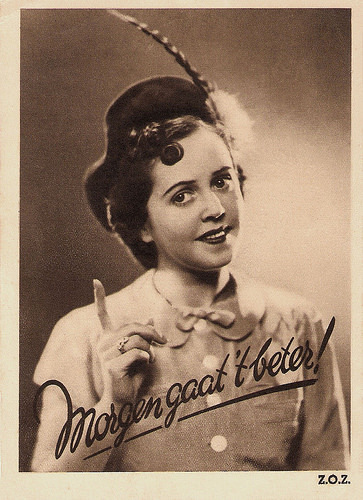
Dutch postcard by Colosseum Theater, Rotterdam. Photo: Neerlandia-Filmex. Publicity still for Morgen gaat het beter/Tomorrow It Will Be Better (Friedrich Zelnik, 1939).
Violinist, dancer or actress?
Lily Geertruida Maria Henriëtte Bouwmeester was born in Amsterdam in 1901. She was the daughter of violinist Ludovicus Adolphus Bouwmeester and pianist Julie Marie Arpeau.
As a child, Lily toured with her parents through Europe, while preparing to become a violinist as well. The touring proved to be too exhausting for Bouwmeester, so in 1913, she moved in with her aunt, the famous actress Theo Mann-Bouwmeester. She dreamed to become a dancer, but her aunt sent her to several theatre auditions. At the age of 14, she debuted in a theatre production of the stage company Tooneelvereeniging managed by author Herman Heijermans.
In 1916, Bouwmeester started acting in silent films as well. She debuted at the Hollandia studios in the silent drama Majoor Frans/Major Francis (Maurits Binger, 1916), which starred Dutch silent film diva Annie Bos. It was followed by by other Hollandia productions such as Het geheim van Delft/The secret of Delft (Maurits Binger, 1917) and Het goudvischje/The Little Gold Fish (Maurits Binger, 1919) with Lily as Annie Bos’s sister.
In 1917, she landed a contract with the prestigious Toneelvereeniging directed by the innovative actor-director Eduard Verkade and she performed at the Stadsschouwburg in Amsterdam. Verkade inspired her to make a real career out of her acting and she was praised by theatre critics.
In the meanwhile, she appeared in films like Pro Domo (Theo Frenkel, 1917) as the daughter of Louis Bouwmeester and Theo Mann Bouwmeester, De duivel in Amsterdam/The Devil in Amsterdam (Theo Frenkel, 1919) with Eduard Verkade as the devil, and Helleveeg/The Shrew (Theo Frenkel, 1920), featuring Mien Duymaer van Twist. Her last silent film was the British-Dutch silent drama Zaken zijn zaken/Sheer Bluff (Frank Richardson, 1921) with Henry Victor.
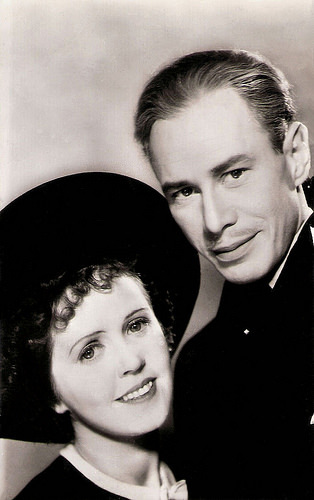
Dutch promotion card by Cinema Odeon, Den Haag. Photo: Neerlandia. Publicity still for Vadertje Langbeen/Daddy Longlegs (Friedrich Zelnik, 1938) with Lily Bouwmeester as Judy and Paul Storm as Vadertje Langbeen.
Eliza Doolittle
Lily Bouwmeester married actor-director Theo Frenkel Jr. in 1921. She left the Stadsschouwburg to produce her own plays with her husband. They moved to the Hague in 1923 and performed in Rotterdam, where she became more famous. Through the years, Bouwmeester developed in theatre and decided she was on her best at comedic roles. She and her husband divorced in 1933.
Two years later, she married stage manager Cor van der Lugt Melsert. He wanted her to become a housewife. Bouwmeester, needing a break from acting, did what she was asked to and left the theatre.
However, she didn't give up acting. In 1935, when the sound film had just been introduced in the Netherlands, she auditioned for the lead role in De Kribbebijter/The Cross-Patch (1935), but was refused on accounts of being 'too plain looking'. But she was noticed by director Ludwig Berger, who cast her as Eliza Doolittle in his Dutch adaptation of G.B. Shaw’s Pygmalion (1937). It would be her first film since 1921.
Pygmalion grew out the be the most successful Dutch Pre-War film. She became an instant star and even had to hire a secretary to handle her fan mail. She was offered a five-year contract with Paramount Pictures. She declined, however, because her husband was unwilling to travel to the United States with her. Instead, she remained acting in the biggest Dutch film productions of the 1930s.
Her following films all became box office hits, with only one exception. With her round face and her big expressive eyes the 37 years old Bouwmeester could easily play young girls in Vadertje Langbeen/Daddy Long Legs (1938) and Morgen gaat het beter/Tomorrow It Will Be Better (1939), both directed by German immigrant director Friedrich Zelnik .
She also convinced as the fragile coquettish wife opposite Jan de Hartog in Ergens in Nederland/Somewhere in the Netherlands (Ludwig Berger, 1940), about the mobilization on the brink of the Second World War. The film was just ready for release when the Netherlands were conquered by the Nazis, who forbade its exhibition. World War II forced the Dutch film industry to stop doing business and Lily Bouwmeester’s promising film career was abruptly and definitively finished.
Long fragments of the silent film Ulbo Garvema (Maurits Binger, 1917). Source: Eye (YouTube).
The Fourposter
During World War II, Lily Bouwmeester refused offers by the German studio Ufa and she secretly took in two Jewish boys in her home in The Hague.
After the liberation in 1945, she was offered film roles again, but declined all offers. She decided to return to the theatre instead and from September 1945 on, she worked for the Residentie Tooneel.
In 1948, she moved to the Rotterdams Toneel for five seasons. She returned in her success role of Eliza Doolittle and would play Pygmalion on stage for more than 800 times. She was also remembered for playing the lead role in the play Het Hemelbed (The Fourposter) in 1952. Author Jan de Hertog had written it especially for her. She would play it more than 500 times.
However, in 1955 she took a break from acting again to take some rest. In 1960 she returned to theatre, performing on stage in Arnhem. Meanwhile, she appeared on several television shows, including the TV film Een stukje van jezelf/A piece of yourself (1967).
In 1969, she resigned from acting completely. After the death of her husband in 1990, she moved to Sliedrecht, where she spent the rest of her life in seclusion. Although she was awarded with a Pre-Golden Calf - being named the ‘Best Actress of Pre-War Dutch Cinema’ - in 1991, she was lonely in her final years.
Lily Bouwmeester died in 1993 in a local hospital in Sliedrecht, at the age of 92. She was cremated in the Hague. She had no children.
First part of Vadertje Langbeen/Daddy Long Legs (1938). Source: Dutchclassics (YouTube).
Clip of Ergens in Nederland/Somewhere in the Netherlands (1940). Source: Eye (YouTube).
This is a post for Postcard Friendship Friday, hosted by Beth at the blog The Best Hearts are Crunchy. You can visit her by clicking on the button below.

Sources: A.J.C.M. Gabriëls (Huygens ING – Dutch), Chip Douglas (IMDb), Wikipedia and I.

Dutch postcard by Colosseum Theater, Rotterdam. Photo: Neerlandia-Filmex. Publicity still for Morgen gaat het beter/Tomorrow It Will Be Better (Friedrich Zelnik, 1939).
Violinist, dancer or actress?
Lily Geertruida Maria Henriëtte Bouwmeester was born in Amsterdam in 1901. She was the daughter of violinist Ludovicus Adolphus Bouwmeester and pianist Julie Marie Arpeau.
As a child, Lily toured with her parents through Europe, while preparing to become a violinist as well. The touring proved to be too exhausting for Bouwmeester, so in 1913, she moved in with her aunt, the famous actress Theo Mann-Bouwmeester. She dreamed to become a dancer, but her aunt sent her to several theatre auditions. At the age of 14, she debuted in a theatre production of the stage company Tooneelvereeniging managed by author Herman Heijermans.
In 1916, Bouwmeester started acting in silent films as well. She debuted at the Hollandia studios in the silent drama Majoor Frans/Major Francis (Maurits Binger, 1916), which starred Dutch silent film diva Annie Bos. It was followed by by other Hollandia productions such as Het geheim van Delft/The secret of Delft (Maurits Binger, 1917) and Het goudvischje/The Little Gold Fish (Maurits Binger, 1919) with Lily as Annie Bos’s sister.
In 1917, she landed a contract with the prestigious Toneelvereeniging directed by the innovative actor-director Eduard Verkade and she performed at the Stadsschouwburg in Amsterdam. Verkade inspired her to make a real career out of her acting and she was praised by theatre critics.
In the meanwhile, she appeared in films like Pro Domo (Theo Frenkel, 1917) as the daughter of Louis Bouwmeester and Theo Mann Bouwmeester, De duivel in Amsterdam/The Devil in Amsterdam (Theo Frenkel, 1919) with Eduard Verkade as the devil, and Helleveeg/The Shrew (Theo Frenkel, 1920), featuring Mien Duymaer van Twist. Her last silent film was the British-Dutch silent drama Zaken zijn zaken/Sheer Bluff (Frank Richardson, 1921) with Henry Victor.

Dutch promotion card by Cinema Odeon, Den Haag. Photo: Neerlandia. Publicity still for Vadertje Langbeen/Daddy Longlegs (Friedrich Zelnik, 1938) with Lily Bouwmeester as Judy and Paul Storm as Vadertje Langbeen.
Eliza Doolittle
Lily Bouwmeester married actor-director Theo Frenkel Jr. in 1921. She left the Stadsschouwburg to produce her own plays with her husband. They moved to the Hague in 1923 and performed in Rotterdam, where she became more famous. Through the years, Bouwmeester developed in theatre and decided she was on her best at comedic roles. She and her husband divorced in 1933.
Two years later, she married stage manager Cor van der Lugt Melsert. He wanted her to become a housewife. Bouwmeester, needing a break from acting, did what she was asked to and left the theatre.
However, she didn't give up acting. In 1935, when the sound film had just been introduced in the Netherlands, she auditioned for the lead role in De Kribbebijter/The Cross-Patch (1935), but was refused on accounts of being 'too plain looking'. But she was noticed by director Ludwig Berger, who cast her as Eliza Doolittle in his Dutch adaptation of G.B. Shaw’s Pygmalion (1937). It would be her first film since 1921.
Pygmalion grew out the be the most successful Dutch Pre-War film. She became an instant star and even had to hire a secretary to handle her fan mail. She was offered a five-year contract with Paramount Pictures. She declined, however, because her husband was unwilling to travel to the United States with her. Instead, she remained acting in the biggest Dutch film productions of the 1930s.
Her following films all became box office hits, with only one exception. With her round face and her big expressive eyes the 37 years old Bouwmeester could easily play young girls in Vadertje Langbeen/Daddy Long Legs (1938) and Morgen gaat het beter/Tomorrow It Will Be Better (1939), both directed by German immigrant director Friedrich Zelnik .
She also convinced as the fragile coquettish wife opposite Jan de Hartog in Ergens in Nederland/Somewhere in the Netherlands (Ludwig Berger, 1940), about the mobilization on the brink of the Second World War. The film was just ready for release when the Netherlands were conquered by the Nazis, who forbade its exhibition. World War II forced the Dutch film industry to stop doing business and Lily Bouwmeester’s promising film career was abruptly and definitively finished.
Long fragments of the silent film Ulbo Garvema (Maurits Binger, 1917). Source: Eye (YouTube).
The Fourposter
During World War II, Lily Bouwmeester refused offers by the German studio Ufa and she secretly took in two Jewish boys in her home in The Hague.
After the liberation in 1945, she was offered film roles again, but declined all offers. She decided to return to the theatre instead and from September 1945 on, she worked for the Residentie Tooneel.
In 1948, she moved to the Rotterdams Toneel for five seasons. She returned in her success role of Eliza Doolittle and would play Pygmalion on stage for more than 800 times. She was also remembered for playing the lead role in the play Het Hemelbed (The Fourposter) in 1952. Author Jan de Hertog had written it especially for her. She would play it more than 500 times.
However, in 1955 she took a break from acting again to take some rest. In 1960 she returned to theatre, performing on stage in Arnhem. Meanwhile, she appeared on several television shows, including the TV film Een stukje van jezelf/A piece of yourself (1967).
In 1969, she resigned from acting completely. After the death of her husband in 1990, she moved to Sliedrecht, where she spent the rest of her life in seclusion. Although she was awarded with a Pre-Golden Calf - being named the ‘Best Actress of Pre-War Dutch Cinema’ - in 1991, she was lonely in her final years.
Lily Bouwmeester died in 1993 in a local hospital in Sliedrecht, at the age of 92. She was cremated in the Hague. She had no children.
First part of Vadertje Langbeen/Daddy Long Legs (1938). Source: Dutchclassics (YouTube).
Clip of Ergens in Nederland/Somewhere in the Netherlands (1940). Source: Eye (YouTube).
This is a post for Postcard Friendship Friday, hosted by Beth at the blog The Best Hearts are Crunchy. You can visit her by clicking on the button below.

Sources: A.J.C.M. Gabriëls (Huygens ING – Dutch), Chip Douglas (IMDb), Wikipedia and I.
Published on October 01, 2015 22:00
September 30, 2015
John van Dreelen
Today EFSP presents in our unofficial Netherlands Film Star Postcards Festival: John van Dreelen (1922-1992). This distinguished Dutch actor played German officers and other bad guys in many European and American films, but he is best remembered as an A-list guest star in dozens of American television shows from the early sixties to the mid-eighties. Van Dreelen also enjoyed an international stage career and starred as Captain von Trapp in the original American touring production of The Sound of Music. His smooth charisma and distinctive Dutch accent kept him in worldwide demand throughout a career that spanned more than 40 years.
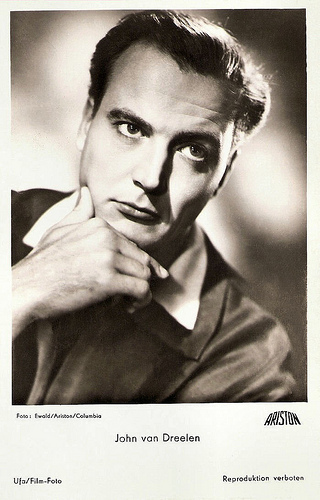
German postcard by Ufa/Film-Foto (Universum-Film A.G., Abt. Film-Foto), Berlin-Tempelhof, no. FK 435. Photo: Ewald / Ariston / Columbia.
Disguised as a German Officer
John van Dreelen was born as Jacques van Drielen Gimberg in Amsterdam, The Netherlands, in 1922. He was the son of celebrated Dutch actor/director Louis Gimberg and the French baroness Josine Elise Labouchere. Despite his mother's desire that he joined her family's well-established porcelain business, young Jack Gimberg chose his father’s profession.
Only 19 years old, he made his stage debut at the Residentie Toneel in Den Haag (The Hague) in 1941. Two years later he was sent to the Emslandlager labour camp near Papenburg in Nazi-occupied Holland, where he was assigned to grueling street construction. In the camp he joined a performers' troupe, and during one performance, he managed to grab a German uniform from the audience cloak room. Fluent in Dutch, English, French, Italian ánd German, he escaped by disguising himself as one of the German officers which he would later so often play on both big and small screens.
After the war, he made his film debut in the Dutch war drama Niet tevergeefs/But Not in Vain (Edmond T. Greville, 1948) with Max Croiset and Jopie Koopman . In France, he played a bit part in the original film version of Colette’s Gigi (Jacqueline Audry, 1949) starring Danièle Delorme and Gaby Morlay .
He was invited by Laurence Olivier to co-star in his 1950 production of Daphne Laureola. He changed his stage name from Jack Gimberg to John Van Dreelen. Following a tour of England, the play landed briefly in New York. There Van Dreelen appeared in a few TV shows, but restrictive immigration laws made it impossible for him to stay in America.
Disappointed he returned to Europe. He played Audrey Hepburn 's husband in both the English and French versions of the comedy Monte Carlo Baby/Nous irons à Monte Carlo (Jean Boyer, Lester Fuller, 1951). Next he appeared in the French crime film Brelan d'as/Full House (Henri Verneuil, 1952) based on stories by Peter Cheney and Georges Siménon.
The following years he mainly appeared in German films, including a leading role in the Heimatfilm Rote Rosen, rote Lippen, roter Wein/Tender and True (Paul Martin, 1953) opposite Gardy Granass , a small role in the war film Der letzte Akt/The Last Ten Days (Georg Wilhelm Pabst, 1955) about the last ten days of Adolph Hitler, and the crime film In Hamburg sind die Nächte lang/In Hamburg Nights Are Long (Max Michel, 1956) with Barbara Rütting .
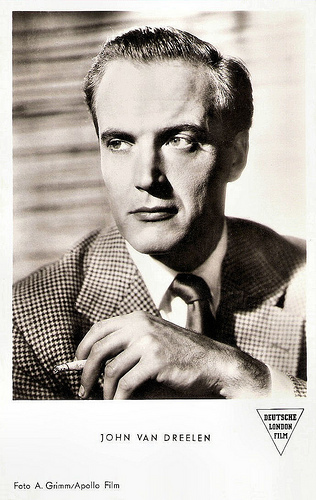
German postcard by Kunst und Bild, Berlin, no. A 823. Photo: Arthur Grimm / Apollo Film / Deutsche London Film. Still for Rote Rosen, rote Lippen, roter Wein/Tender and True (1953).
The Man Who Shot Frank Sinatra
John van Dreelen made his U.S. film debut in A Time to Love and a Time to Die (Douglas Sirk, 1958), a grim movie about Germany in the last months of World War II. Director Douglas Sirk was instrumental in helping John and his wife Jane emigrate to America. Although he would never become a major player in the American cinema, he nonetheless scored a few choice roles in the following years.
He was one of the victims of Coleen Gray in the horror/SciFi film The Leech Woman (Edward Dein, 1960). In Von Ryan’s Express (Mark Robson, 1965) he played a German officer who shot Frank Sinatra. During the rest of his career he would play many more German officers and other bad guys.
Despite his close identification with despotic roles, he also easily breezed through light drama and comedy. For instance as a Danish concert pianist who rescues and woos Lana Turner during an extended sequence in Madame X (David Lowell Rich, 1966).
But he is best remembered for his guest starring roles in many legendary TV series. He cut a dashing and memorable villain in such sixties pop culture series as Gunsmoke (1961), Rawhide (1962), Twilight Zone (1964), The Man from U.N.C.L.E. (1964), Perry Mason (1964-1965), I Spy (1965), Mission: Impossible (1967), The Mod Squad (1968) and The Wild Wild West (1966-1969). Van Dreelen became the quintessential urbane sadist. His turns as unrepentant Nazis, aristocratic dictators, and cold-blooded Iron Curtain assassins are without peer.
Van Dreelen also enjoyed an international stage career and starred in 1962 as Captain Von Trapp in the first national tour of The Sound of Music opposite alternately Barbara Meister and Jeannie Carson. He was considered composer Richard Rodgers's first choice to play the film role that eventually went to Christopher Plummer. It was the most bitter disappointment of Van Dreelen’s career.
A Tribute to Madame X (1966). Source: Monique classique (YouTube).
Memorable TV Series
John van Dreelen continued to appear in both Hollywood movies and European films. Among his later films are the satire Die Ente klingelt um halb acht/The Duck Rings at Half Past Seven (Rolf Thiele, 1968) with Heinz Rühmann , the Cold War thriller Topaz (Alfred Hitchcock, 1969), the musical Lost Horizon (Charles Jarrott, 1973), the thriller The Formula (John G. Advilsen, 1980) with Marlon Brando, and the silly slapstick romance The Money Pit (Richard Benjamin, 1986) starring Tom Hanks.
Meanwhile he guest-starred in such memorable TV series as Get Smart (1970), McCloud (1970), Ironside (1967-1970), the German Krimi Tatort (1974), Police Story (1975), The Six Million Dollar Man (1974-1976), Charlie’s Angels (1977), The Rockford Files (1978), The New Adventures of Wonder Woman (1978), Falcon Crest (1984), Knight Rider (1985), Dynasty (1985) and Airwolf (1985).
In the last phase of his career he returned to Europe, especially to Germany and the country where he was born, the Netherlands. Through the years he had appeared in Dutch productions such as the TV musical Vadertje Langbeen/Daddy Longlegs (Willy van Hemert, 1964) opposite Jenny Arean, the TV series De kleine Zielen/The Little Souls (Bob Löwenstein, 1969-1970) based on the novel by Louis Couperus, the action film Rufus (Samuel Meyering, 1975) opposite Rijk de Gooyer and Yoka Berretty , the thriller Mascara (1987, Patrick Conrad) starring Charlotte Rampling , Odyssée d'amour (1987, Pim de la Parra), the romantic thriller Zoeken naar Eileen/Looking for Eileen (Rudolf van den Berg, 1987) with Thom Hoffman, and the sweet TV comedy Beppie (Rob Herzet, 1989).
His final film was the German-English-French production Becoming Colette (Danny Huston, 1991) starring Mathilda May as the young writer Colette.
John van Dreelen died in 1992 in Cap d’Agde. The Dutch press acknowledged the passing of one of its most famous expatriates. Van Dreelen was married three times. His second and third wives were dancer Rosemarie Rand and Philippine Rosemarie Detayo.
Scenes from the Dutch TV series De kleine Zielen/The Little Souls (1969-1970). Source: John Knap (YouTube).
Sources: (IMDb), Wikipedia, and .

German postcard by Ufa/Film-Foto (Universum-Film A.G., Abt. Film-Foto), Berlin-Tempelhof, no. FK 435. Photo: Ewald / Ariston / Columbia.
Disguised as a German Officer
John van Dreelen was born as Jacques van Drielen Gimberg in Amsterdam, The Netherlands, in 1922. He was the son of celebrated Dutch actor/director Louis Gimberg and the French baroness Josine Elise Labouchere. Despite his mother's desire that he joined her family's well-established porcelain business, young Jack Gimberg chose his father’s profession.
Only 19 years old, he made his stage debut at the Residentie Toneel in Den Haag (The Hague) in 1941. Two years later he was sent to the Emslandlager labour camp near Papenburg in Nazi-occupied Holland, where he was assigned to grueling street construction. In the camp he joined a performers' troupe, and during one performance, he managed to grab a German uniform from the audience cloak room. Fluent in Dutch, English, French, Italian ánd German, he escaped by disguising himself as one of the German officers which he would later so often play on both big and small screens.
After the war, he made his film debut in the Dutch war drama Niet tevergeefs/But Not in Vain (Edmond T. Greville, 1948) with Max Croiset and Jopie Koopman . In France, he played a bit part in the original film version of Colette’s Gigi (Jacqueline Audry, 1949) starring Danièle Delorme and Gaby Morlay .
He was invited by Laurence Olivier to co-star in his 1950 production of Daphne Laureola. He changed his stage name from Jack Gimberg to John Van Dreelen. Following a tour of England, the play landed briefly in New York. There Van Dreelen appeared in a few TV shows, but restrictive immigration laws made it impossible for him to stay in America.
Disappointed he returned to Europe. He played Audrey Hepburn 's husband in both the English and French versions of the comedy Monte Carlo Baby/Nous irons à Monte Carlo (Jean Boyer, Lester Fuller, 1951). Next he appeared in the French crime film Brelan d'as/Full House (Henri Verneuil, 1952) based on stories by Peter Cheney and Georges Siménon.
The following years he mainly appeared in German films, including a leading role in the Heimatfilm Rote Rosen, rote Lippen, roter Wein/Tender and True (Paul Martin, 1953) opposite Gardy Granass , a small role in the war film Der letzte Akt/The Last Ten Days (Georg Wilhelm Pabst, 1955) about the last ten days of Adolph Hitler, and the crime film In Hamburg sind die Nächte lang/In Hamburg Nights Are Long (Max Michel, 1956) with Barbara Rütting .

German postcard by Kunst und Bild, Berlin, no. A 823. Photo: Arthur Grimm / Apollo Film / Deutsche London Film. Still for Rote Rosen, rote Lippen, roter Wein/Tender and True (1953).
The Man Who Shot Frank Sinatra
John van Dreelen made his U.S. film debut in A Time to Love and a Time to Die (Douglas Sirk, 1958), a grim movie about Germany in the last months of World War II. Director Douglas Sirk was instrumental in helping John and his wife Jane emigrate to America. Although he would never become a major player in the American cinema, he nonetheless scored a few choice roles in the following years.
He was one of the victims of Coleen Gray in the horror/SciFi film The Leech Woman (Edward Dein, 1960). In Von Ryan’s Express (Mark Robson, 1965) he played a German officer who shot Frank Sinatra. During the rest of his career he would play many more German officers and other bad guys.
Despite his close identification with despotic roles, he also easily breezed through light drama and comedy. For instance as a Danish concert pianist who rescues and woos Lana Turner during an extended sequence in Madame X (David Lowell Rich, 1966).
But he is best remembered for his guest starring roles in many legendary TV series. He cut a dashing and memorable villain in such sixties pop culture series as Gunsmoke (1961), Rawhide (1962), Twilight Zone (1964), The Man from U.N.C.L.E. (1964), Perry Mason (1964-1965), I Spy (1965), Mission: Impossible (1967), The Mod Squad (1968) and The Wild Wild West (1966-1969). Van Dreelen became the quintessential urbane sadist. His turns as unrepentant Nazis, aristocratic dictators, and cold-blooded Iron Curtain assassins are without peer.
Van Dreelen also enjoyed an international stage career and starred in 1962 as Captain Von Trapp in the first national tour of The Sound of Music opposite alternately Barbara Meister and Jeannie Carson. He was considered composer Richard Rodgers's first choice to play the film role that eventually went to Christopher Plummer. It was the most bitter disappointment of Van Dreelen’s career.
A Tribute to Madame X (1966). Source: Monique classique (YouTube).
Memorable TV Series
John van Dreelen continued to appear in both Hollywood movies and European films. Among his later films are the satire Die Ente klingelt um halb acht/The Duck Rings at Half Past Seven (Rolf Thiele, 1968) with Heinz Rühmann , the Cold War thriller Topaz (Alfred Hitchcock, 1969), the musical Lost Horizon (Charles Jarrott, 1973), the thriller The Formula (John G. Advilsen, 1980) with Marlon Brando, and the silly slapstick romance The Money Pit (Richard Benjamin, 1986) starring Tom Hanks.
Meanwhile he guest-starred in such memorable TV series as Get Smart (1970), McCloud (1970), Ironside (1967-1970), the German Krimi Tatort (1974), Police Story (1975), The Six Million Dollar Man (1974-1976), Charlie’s Angels (1977), The Rockford Files (1978), The New Adventures of Wonder Woman (1978), Falcon Crest (1984), Knight Rider (1985), Dynasty (1985) and Airwolf (1985).
In the last phase of his career he returned to Europe, especially to Germany and the country where he was born, the Netherlands. Through the years he had appeared in Dutch productions such as the TV musical Vadertje Langbeen/Daddy Longlegs (Willy van Hemert, 1964) opposite Jenny Arean, the TV series De kleine Zielen/The Little Souls (Bob Löwenstein, 1969-1970) based on the novel by Louis Couperus, the action film Rufus (Samuel Meyering, 1975) opposite Rijk de Gooyer and Yoka Berretty , the thriller Mascara (1987, Patrick Conrad) starring Charlotte Rampling , Odyssée d'amour (1987, Pim de la Parra), the romantic thriller Zoeken naar Eileen/Looking for Eileen (Rudolf van den Berg, 1987) with Thom Hoffman, and the sweet TV comedy Beppie (Rob Herzet, 1989).
His final film was the German-English-French production Becoming Colette (Danny Huston, 1991) starring Mathilda May as the young writer Colette.
John van Dreelen died in 1992 in Cap d’Agde. The Dutch press acknowledged the passing of one of its most famous expatriates. Van Dreelen was married three times. His second and third wives were dancer Rosemarie Rand and Philippine Rosemarie Detayo.
Scenes from the Dutch TV series De kleine Zielen/The Little Souls (1969-1970). Source: John Knap (YouTube).
Sources: (IMDb), Wikipedia, and .
Published on September 30, 2015 22:00
September 29, 2015
Willem Nijholt
In the Unofficial Netherlands Film Star Postcards Festival (NFSPF), today a post on Dutch actor, and also dancer and singer, Willem Nijholt (1934). His versatility led him to work in musicals, TV shows, stage plays, cabaret and in several films. In recent years he has also become known as a TV juror and author.

Dutch autograph card.
Started With Nothing
Willem Adrianus Nijholt was born in Gombong, Kedoe, the Dutch East Indies (now Indonesia) in 1934. He was the son of Jan Nijholt, a KNIL instructor, and Willemina Sophia Maria Arntz.
At age eight he ended up in a Japanese POW camp, which left a deep scar for the rest of his life. At fourteen, he saw his father again, who was sent to work on the Burma Railway by the Japanese.
After World War II, the family left the Dutch East Indies and settled in Millingen, the birthplace of his mother. Nijholt attended temporarily HBS (Higher Civic School) in Nijmegen, was briefly in the Navy and went to study at the school for dramatic arts in Amsterdam at age 23. His ill mother died in 1959, before she could see him performing on stage.
Nijholt fell in love with the author Gerard Reve, who rejected him, but in 1962 he played a role in Reve’s play Commissaris Fennedy/Commissioner Fennedy and the two connected. His letters to Reve are published in the book Met Niets Begonnen (Started With Nothing).
He made his screen debut in the TV film De huzaren/The Hussars (Walter van der Kamp, 1960). In 1964 he performed the role of Hoofd Piet (Head Pete) once during the national arrival of Sinterklaas in Hoorn. In 1968 he appeared in the popular satirical TV Show Hadimassa. He became very popular among children with his part in the innovative TV show Oebele (Bram van Erkel, 1968-1972) with Wieteke van Dort. And he made his film debut in Daniel (Erik Terpstra, 1971) with Peter Schaapman.
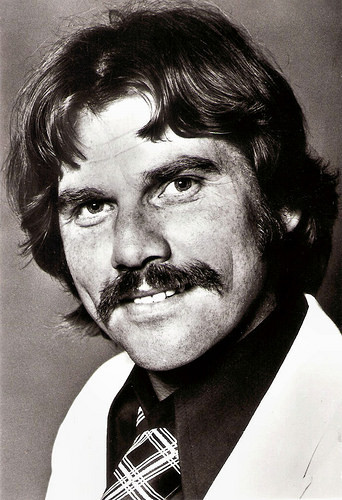
Dutch card.
The Duch equivalent of the Academy Award
In the 1970s, Willem Nijholt had his definitive breakthrough. On stage, he worked with Wim Sonneveld in a successful cabaret show in 1971.
In 1974 he played Theo Oudijck in the popular TV series De stille kracht/The Silent Force (Walter van der Kamp, 1974), with Pleuni Touw. Their nude scene was a big sensation. He also played Ben van Rooyen in the youth series De Kris Pusaka/The Kris Pusaka (Bram van Erkel, 1977).
Nijholt starred in several stage musicals, including Wat een planeet (What a planet; 1973) and Foxtrot (1977), written by Annie MG Schmidt. In 1977 he was awarded the Johan Kaartprijs (Johan Kaart award).
In 1981 he played a voice teacher in the play Children of a Lesser God. He was asked to play this role in London too, but he did not accept the offer.
He played roles in Dutch films like the box office hit Ciske de Rat (Guido Pieters, 1984) with Danny de Munk and Willeke van Ammelrooy, and Havinck (Frans Weisz, 1987) in which he played the title character. Chip Douglas at IMDb : “Nijholt, at age 50, was ten years too old. But director Frans Weisz, who screen testing countless leading men opposite (debutant Anne Martien) Lousberg, still wanted Nijholt to read with her, because he had a feeling Willem could bring out the best in Anne Martien. The young actress obviously felt the same way, because she decided there and then that Nijholt was the one to play her father. He ended up winning the coveted 'Golden Calf' award (the Duch equivalent of the Academy Award) for his efforts.”
In 1989 he played the lead role in the short film Alaska, Mike van Diem’s graduation film at the Dutch Film and Television Academy. The film won a Golden Calf and a Student Academy Award. In 1989, Nijholt played the Master of Ceremonies in the musical Cabaret (1989). That year, actor Guido de Moor passed to him the prestigious Paul Steenbergen medal, which he passed in 2002 to actor Pierre Bokma.
Wim Sonneveld & Willem Nijholt in a registration of the Wim Sonneveld Show (1974). Sorry, no subtitles. Source: NostalgieTheater (YouTube).
The Last Call
Willem Nijholt played part in the acclaimed TV series Bij nader inzien/On closer inspection (Frans Weisz, 1991) and Op afbetaling/In part-payment (Frans Weisz, 1993) with Renée Soutendijk.
He also continued to appear regularly in Dutch films. He played Etienne in the Harry Mulisch adaptation Hoogste Tijd/The Last Call (Frans Weisz, 1995) starring Rijk de Gooijer. He appeared with Helmut Berger and Udo Kier in Unter den Palmen/Under the palms (Miriam Kruishoop, 1999) and reunited with Pleuni Touw in De vriendschap/The friendship (Nouchka van Brakel, 2001).
Nijholt appeared in several family films, including Pietje Bell/Peter Bell (Maria Peters, 2002), Pietje Bell 2: De Jacht op de Tsarenkroon/Peter Bell II: The Hunt for the Czar Crown (Maria Peters, 2003) and De Griezelbus/The Horror Bus (Pieter Kuijpers, 2005).
Willem Nijholt enjoyed a massive success when he played the controller in the Dutch edition of the stage musical Miss Saigon (1996). Another great musical role was Fagin in Oliver! (1999-2000).
In 2002 he retired from the musical and in 2004 he played his last stage role. In 1999 Willem Nijholt was appointed Officer in the Order of Orange-Nassau. In the television talent quest show Op zoek naar ... (2007-2011; Looking for Evita, Looking for Joseph, Looking for Mary Poppins and Looking for Zorro), Nijholt was the juror.
Since 2011 he is a Knight in the Order of the Netherlands Lion. His most recent screen role was in the TV crime series Penoza II (Diederik Van Rooijen, 2012-2013), starring Monic Hendrickx.
Willem Nijholt sings Koen de Postkoetsboef in the TV show Oebele (ca. 1972). Sorry, no subtitles. Source: Geluidsjager (YouTube).
Scene from Ciske de Rat (Guido Pieters, 1984). Sorry, no subtitles. Source: Nostalgische Tijden (YouTube).
Sources: Chip Douglas (IMDb), Een leven lang theater (Dutch), Wikipedia (Dutch), and .

Dutch autograph card.
Started With Nothing
Willem Adrianus Nijholt was born in Gombong, Kedoe, the Dutch East Indies (now Indonesia) in 1934. He was the son of Jan Nijholt, a KNIL instructor, and Willemina Sophia Maria Arntz.
At age eight he ended up in a Japanese POW camp, which left a deep scar for the rest of his life. At fourteen, he saw his father again, who was sent to work on the Burma Railway by the Japanese.
After World War II, the family left the Dutch East Indies and settled in Millingen, the birthplace of his mother. Nijholt attended temporarily HBS (Higher Civic School) in Nijmegen, was briefly in the Navy and went to study at the school for dramatic arts in Amsterdam at age 23. His ill mother died in 1959, before she could see him performing on stage.
Nijholt fell in love with the author Gerard Reve, who rejected him, but in 1962 he played a role in Reve’s play Commissaris Fennedy/Commissioner Fennedy and the two connected. His letters to Reve are published in the book Met Niets Begonnen (Started With Nothing).
He made his screen debut in the TV film De huzaren/The Hussars (Walter van der Kamp, 1960). In 1964 he performed the role of Hoofd Piet (Head Pete) once during the national arrival of Sinterklaas in Hoorn. In 1968 he appeared in the popular satirical TV Show Hadimassa. He became very popular among children with his part in the innovative TV show Oebele (Bram van Erkel, 1968-1972) with Wieteke van Dort. And he made his film debut in Daniel (Erik Terpstra, 1971) with Peter Schaapman.

Dutch card.
The Duch equivalent of the Academy Award
In the 1970s, Willem Nijholt had his definitive breakthrough. On stage, he worked with Wim Sonneveld in a successful cabaret show in 1971.
In 1974 he played Theo Oudijck in the popular TV series De stille kracht/The Silent Force (Walter van der Kamp, 1974), with Pleuni Touw. Their nude scene was a big sensation. He also played Ben van Rooyen in the youth series De Kris Pusaka/The Kris Pusaka (Bram van Erkel, 1977).
Nijholt starred in several stage musicals, including Wat een planeet (What a planet; 1973) and Foxtrot (1977), written by Annie MG Schmidt. In 1977 he was awarded the Johan Kaartprijs (Johan Kaart award).
In 1981 he played a voice teacher in the play Children of a Lesser God. He was asked to play this role in London too, but he did not accept the offer.
He played roles in Dutch films like the box office hit Ciske de Rat (Guido Pieters, 1984) with Danny de Munk and Willeke van Ammelrooy, and Havinck (Frans Weisz, 1987) in which he played the title character. Chip Douglas at IMDb : “Nijholt, at age 50, was ten years too old. But director Frans Weisz, who screen testing countless leading men opposite (debutant Anne Martien) Lousberg, still wanted Nijholt to read with her, because he had a feeling Willem could bring out the best in Anne Martien. The young actress obviously felt the same way, because she decided there and then that Nijholt was the one to play her father. He ended up winning the coveted 'Golden Calf' award (the Duch equivalent of the Academy Award) for his efforts.”
In 1989 he played the lead role in the short film Alaska, Mike van Diem’s graduation film at the Dutch Film and Television Academy. The film won a Golden Calf and a Student Academy Award. In 1989, Nijholt played the Master of Ceremonies in the musical Cabaret (1989). That year, actor Guido de Moor passed to him the prestigious Paul Steenbergen medal, which he passed in 2002 to actor Pierre Bokma.
Wim Sonneveld & Willem Nijholt in a registration of the Wim Sonneveld Show (1974). Sorry, no subtitles. Source: NostalgieTheater (YouTube).
The Last Call
Willem Nijholt played part in the acclaimed TV series Bij nader inzien/On closer inspection (Frans Weisz, 1991) and Op afbetaling/In part-payment (Frans Weisz, 1993) with Renée Soutendijk.
He also continued to appear regularly in Dutch films. He played Etienne in the Harry Mulisch adaptation Hoogste Tijd/The Last Call (Frans Weisz, 1995) starring Rijk de Gooijer. He appeared with Helmut Berger and Udo Kier in Unter den Palmen/Under the palms (Miriam Kruishoop, 1999) and reunited with Pleuni Touw in De vriendschap/The friendship (Nouchka van Brakel, 2001).
Nijholt appeared in several family films, including Pietje Bell/Peter Bell (Maria Peters, 2002), Pietje Bell 2: De Jacht op de Tsarenkroon/Peter Bell II: The Hunt for the Czar Crown (Maria Peters, 2003) and De Griezelbus/The Horror Bus (Pieter Kuijpers, 2005).
Willem Nijholt enjoyed a massive success when he played the controller in the Dutch edition of the stage musical Miss Saigon (1996). Another great musical role was Fagin in Oliver! (1999-2000).
In 2002 he retired from the musical and in 2004 he played his last stage role. In 1999 Willem Nijholt was appointed Officer in the Order of Orange-Nassau. In the television talent quest show Op zoek naar ... (2007-2011; Looking for Evita, Looking for Joseph, Looking for Mary Poppins and Looking for Zorro), Nijholt was the juror.
Since 2011 he is a Knight in the Order of the Netherlands Lion. His most recent screen role was in the TV crime series Penoza II (Diederik Van Rooijen, 2012-2013), starring Monic Hendrickx.
Willem Nijholt sings Koen de Postkoetsboef in the TV show Oebele (ca. 1972). Sorry, no subtitles. Source: Geluidsjager (YouTube).
Scene from Ciske de Rat (Guido Pieters, 1984). Sorry, no subtitles. Source: Nostalgische Tijden (YouTube).
Sources: Chip Douglas (IMDb), Een leven lang theater (Dutch), Wikipedia (Dutch), and .
Published on September 29, 2015 22:00
September 28, 2015
Corry Vonk
At the Unofficial Netherlands Film Star Postcards Festival (NFSPF), today a post on a star of the Dutch cabaret and revue, Corry Vonk (1901-1988). In the 1930s, she also often appeared in some Dutch films.
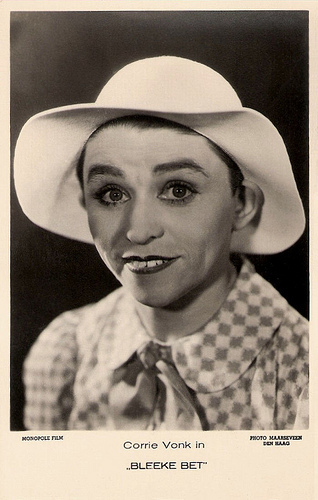
Dutch postcard by M.B. & Z. (M. Bonnist & Zonen, Amsterdam). Photo: Monopole Film/Dick van Maarseveen, Den Haag. Publicity still for Bleeke Bet (1934).
Cabaret
Cornelia Diederika Vonk was born in Amsterdam, The Netherlands in 1901. Her father was the stage manager of Theater Carré, the most famous theatre in Amsterdam.
At 12, Corry (sometimes written as Corrie) made her stage debut with the theatre company of Nap de la Mar, the father of the legendary Dutch actress Fien de la Mar . Later she worked for the companies of cabaret star Louis Davids and actor/director Eduard Verkade .
In 1933 she married cabaret artist Wim Kan, who was almost ten years younger.
In the 1930s she played some supporting parts in Dutch films, like in Bleeke Bet/Bleak Beth (Alex Benno, Richard Oswald, 1934), De Suikerfreule/The Sugar Countess (Haro van Peski, 1935) with Johan Elsensohn, Kermisgasten/Show People (Jaap Speyer, 1936) with Johan Kaart , and Komedie om geld/The Trouble with Money (Max Ophüls, 1936).
She also co-wrote the scenario for the hit film Pygmalion (Ludwig Berger, 1937) based on the play by George Bernard Shaw. In 1936 Wim Kan started the ABC-cabaret, of which his wife was the big star. Kan wrote some texts for her which became classics of the Dutch cabaret, including the monologue Het konijn is dood (The bunny is dead).

Dutch Postcard by Monopole Film, Rotterdam. Photo: Dick van Maarseveen, Den Haag (The Hague). Publicity still for Bleeke Bet (1934).
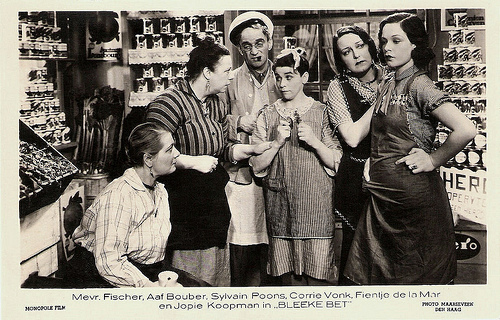
Dutch Postcard by Monopole Film, Rotterdam. Photo: Dick van Maarseveen, Den Haag (The Hague). Publicity still for Bleeke Bet (1934).
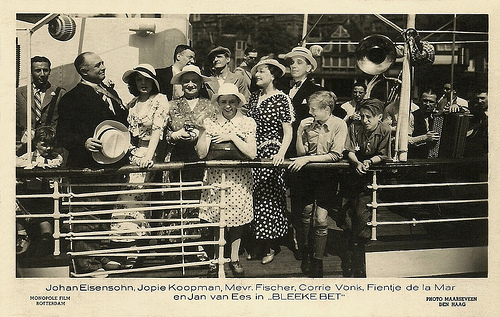
Dutch Postcard by Monopole Film, Rotterdam. Photo: Dick van Maarseveen, Den Haag (The Hague). Publicity still for Bleeke Bet (1934).
Japanese Concentration Camp
In 1939 Corry Vonk, Wim Kan and the ABC-cabaret left for a tour through the Dutch East Indies. 2279 days later they could finally return. During the Japanese occupation Corry was imprisoned in the concentration camp Tjimahi.
Buttercup2009 commented on Flickr at the first postcard in this post: "The book, The Way of a Boy - a Memoir of Java by Ernest Hillen who was 7 years old at the time of the Japanese invasion of the Dutch East Indies, has some heart warming recollections of Corry Vonk - her selflessness (sharing her food and volunteering for a job no one else wanted - washing bandages at the hospital) and her courage as well as her wisdom. She organized a theatre group in the camp that lifted the spirits of both the participants and the audience. She showed by example how to keep one's goodness in the face of adversity".
After the war, the ABC-cabaret made a come back. Corry Vonk, who had become older, moved to the background. In the following decades Wim Kan became one of the three great stars of the Dutch post-war cabaret.
Corry had some major successes too, such as the 1966 song Met me vlaggetje, me hoedje en me toeter (With me flag, me hat and me horn). And she always appeared on stage at the end of her husband’s legendary one man shows at New Year’s Eve.
In 1982 Corry Vonk was stricken by a brain haemorrhage. One year later Wim Kan died. The last years of her life she passed in seclusion. In 1988 she died in Rheden, the Netherlands at the age of 86.
Trailer of Komedie om geld/The Trouble with Money (1936). Source: Flawless 1212 (YouTube).
Corry Vonk sings Met me vlaggetje, me hoedje en me toeter (With me flag, me hat and me horn). Source: Vanalleswat33 (YouTube).
Sources: Buttercup2009 (Flickr), Wikipedia, and .

Dutch postcard by M.B. & Z. (M. Bonnist & Zonen, Amsterdam). Photo: Monopole Film/Dick van Maarseveen, Den Haag. Publicity still for Bleeke Bet (1934).
Cabaret
Cornelia Diederika Vonk was born in Amsterdam, The Netherlands in 1901. Her father was the stage manager of Theater Carré, the most famous theatre in Amsterdam.
At 12, Corry (sometimes written as Corrie) made her stage debut with the theatre company of Nap de la Mar, the father of the legendary Dutch actress Fien de la Mar . Later she worked for the companies of cabaret star Louis Davids and actor/director Eduard Verkade .
In 1933 she married cabaret artist Wim Kan, who was almost ten years younger.
In the 1930s she played some supporting parts in Dutch films, like in Bleeke Bet/Bleak Beth (Alex Benno, Richard Oswald, 1934), De Suikerfreule/The Sugar Countess (Haro van Peski, 1935) with Johan Elsensohn, Kermisgasten/Show People (Jaap Speyer, 1936) with Johan Kaart , and Komedie om geld/The Trouble with Money (Max Ophüls, 1936).
She also co-wrote the scenario for the hit film Pygmalion (Ludwig Berger, 1937) based on the play by George Bernard Shaw. In 1936 Wim Kan started the ABC-cabaret, of which his wife was the big star. Kan wrote some texts for her which became classics of the Dutch cabaret, including the monologue Het konijn is dood (The bunny is dead).

Dutch Postcard by Monopole Film, Rotterdam. Photo: Dick van Maarseveen, Den Haag (The Hague). Publicity still for Bleeke Bet (1934).

Dutch Postcard by Monopole Film, Rotterdam. Photo: Dick van Maarseveen, Den Haag (The Hague). Publicity still for Bleeke Bet (1934).

Dutch Postcard by Monopole Film, Rotterdam. Photo: Dick van Maarseveen, Den Haag (The Hague). Publicity still for Bleeke Bet (1934).
Japanese Concentration Camp
In 1939 Corry Vonk, Wim Kan and the ABC-cabaret left for a tour through the Dutch East Indies. 2279 days later they could finally return. During the Japanese occupation Corry was imprisoned in the concentration camp Tjimahi.
Buttercup2009 commented on Flickr at the first postcard in this post: "The book, The Way of a Boy - a Memoir of Java by Ernest Hillen who was 7 years old at the time of the Japanese invasion of the Dutch East Indies, has some heart warming recollections of Corry Vonk - her selflessness (sharing her food and volunteering for a job no one else wanted - washing bandages at the hospital) and her courage as well as her wisdom. She organized a theatre group in the camp that lifted the spirits of both the participants and the audience. She showed by example how to keep one's goodness in the face of adversity".
After the war, the ABC-cabaret made a come back. Corry Vonk, who had become older, moved to the background. In the following decades Wim Kan became one of the three great stars of the Dutch post-war cabaret.
Corry had some major successes too, such as the 1966 song Met me vlaggetje, me hoedje en me toeter (With me flag, me hat and me horn). And she always appeared on stage at the end of her husband’s legendary one man shows at New Year’s Eve.
In 1982 Corry Vonk was stricken by a brain haemorrhage. One year later Wim Kan died. The last years of her life she passed in seclusion. In 1988 she died in Rheden, the Netherlands at the age of 86.
Trailer of Komedie om geld/The Trouble with Money (1936). Source: Flawless 1212 (YouTube).
Corry Vonk sings Met me vlaggetje, me hoedje en me toeter (With me flag, me hat and me horn). Source: Vanalleswat33 (YouTube).
Sources: Buttercup2009 (Flickr), Wikipedia, and .
Published on September 28, 2015 22:00
September 27, 2015
Thea Fleming
At the Unofficial Netherlands Film Star Postcards Festival (NFSPF), we present today a post on blonde starlet Thea Fleming (1942). She started as the 'Dutch Brigitte Bardot' and spent much of her career in Rome. There she appeared in several Italian B-films under the stage name Isabella Biancini. During the 1960s and early 1970s, she also starred in and directed several fotoromanzi, the popular Italian photo novels.

Italian collectors card by La Rotografica Romana. Edito dalla Nat Nuova Alta Tensione.
A double for Anita Ekberg
Thea Fleming (also Flemming or Flammy) was born as Thea Catharina Wihelmina Gemma Pfennings in 1942 in Sittard in the south of the Netherlands. Her parents, Nou Pfennings and Mia Pfennings-Courage, were innkeepers. She has a brother, Jack.
In 1960 she was chosen as the Dutch BB (Brigitte Bardot). During a vacation with her mother in Italy, she reportedly was discovered by a film producer.
Her first film appearance was a bit part in the drama La giornata balorda/A Crazy Day (Mauro Bolognini, 1960) with Jean Sorel . The script about the lower class of Rome was written by Pier Paolo Pasolini based on a novel by Alberto Moravia.
She stayed in Rome and worked as a double for Anita Ekberg in La dolce vita (Federico Fellini, 1960), according to local Dutch news reports. Another uncredited part followed in the comedy Letto a tre piazza/A bed for three (Steno, 1961) starring Totò and Peppino De Filippo . She had also a small but credited role in the comedy Mariti a congress/Husbands in Congress (Luigi Filippo D'Amico, 1961) with Walter Chiari.
As Thea Flammy, she appeared in the musicarello Canzoni a tempo di twist/Songs with a twist beat (Stefano Canzio, 1962) with Little Tony . Her first bigger part was in the adventure film Taur, il re della forza bruta/Taur the Mighty (Antonio Leonviola, 1963), starring British wrestler Joe Robinson. Richard R. Chandeler at IMDb : “The story is about these bad people oppressing these innocent villagers and how Taur and his cowardly (but equally muscle-bound) companion go about liberating them. This movie is just horribly dull and mostly devoid of even unintentional humor.”
Credited as Isabella Biancini, she had a small part in the much better comedy Il successo/The Success (Mauro Morassi, Dino Risi (uncredited), 1963), starring Vittorio Gassman and Anouk Aimée . Excellent was also the comedy I mostri/15 from Rome (Dino Risi, 1963) with Vittorio Gassman and Ugo Tognazzi , but again her part was small.
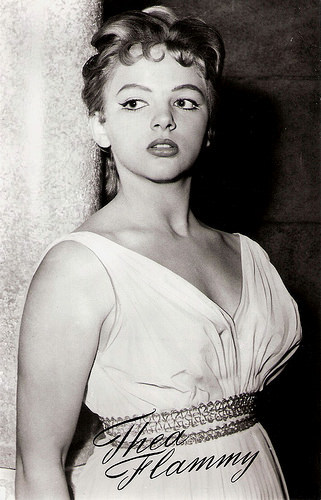
Dutch postcard by Uitg. Takken, Utrecht, no. AX 4648.
Director of fotoromanzi
Although local Dutch newspaper reports of the 1960s always called Thea Fleming a ‘film diva’, her actual film career in Italy was rather modest. As a starlet, she played small roles in quality films and bigger parts in exploitation films and she posed for countless glamour photos.
Fleming played supporting parts in little known trash as the sexploitation film Salome '73 (Odoardo Fiory, 1965), the Eurospy film Asso di picche - Operazione controspionaggio/Operation Counterspy (Nick Nostro, 1965) and the comedy Mondo pazzo... gente matta!/Crazy world... crazy people! (Renato Polselli, 1966) starring Silvana Pampanini .
She had one of her biggest parts in the thriller Il nostro agente a Casablanca/The Killer Lacks a Name (Tulio Demicheli, 1966). Next she had a part in the crime comedy L'assalto al centro nucleare/The Million Dollar Countdown (Mario Caiano, 1967) starring Frank Wolff, and in the war film Uccidete Rommel/Kill Rommel! (Alfonso Brescia, 1969) with Anton Diffring.
Her last film at IMDb is the sex comedy Come fu che Masuccio Salernitano, fuggendo con le brache in mano, riuscì a conservarlo sano/How to cuckold jealous husbands (Silvio Amadio, 1972).
She had a second career in the popular fotoromanzi or fotonovelas of the 1960s and 1970s. She appeared in such Italian and Spanish photo novels as O anjo da moret/The Angel of Death (1970) and Killing 5 La grande fuga. She worked not only as an actress/model but also as a director under the name of Claudia Courage.
According to Dutch newspaper reports she was engaged in the mid-1960s to film actor Giancarlo Viola (Giancarlo del Duca), the son of an airplane engineer. In 1973, she married the British singer-songwriter Michael Shepstone, known for writing hits like Yellow Boomerang by Middle of the Road. In 1974 their daughter Jessica was born. After that Thea Shepstone-Fleming lived with her family in Bournemouth, Great Britain.
Trailer Canzoni a tempo di twist/Songs with a twist beat (1962). Source: giuser56 (YouTube).
Yellow Boomerang (1973) by Middle of the Road. Source: fritz5134 (YouTube).
Sources: Richard R. Chandeler (IMDb), Delpher (Dutch), Nationaal Archief (Dutch), Italian Cinema Database, Killingmania, Wikipedia and .

Italian collectors card by La Rotografica Romana. Edito dalla Nat Nuova Alta Tensione.
A double for Anita Ekberg
Thea Fleming (also Flemming or Flammy) was born as Thea Catharina Wihelmina Gemma Pfennings in 1942 in Sittard in the south of the Netherlands. Her parents, Nou Pfennings and Mia Pfennings-Courage, were innkeepers. She has a brother, Jack.
In 1960 she was chosen as the Dutch BB (Brigitte Bardot). During a vacation with her mother in Italy, she reportedly was discovered by a film producer.
Her first film appearance was a bit part in the drama La giornata balorda/A Crazy Day (Mauro Bolognini, 1960) with Jean Sorel . The script about the lower class of Rome was written by Pier Paolo Pasolini based on a novel by Alberto Moravia.
She stayed in Rome and worked as a double for Anita Ekberg in La dolce vita (Federico Fellini, 1960), according to local Dutch news reports. Another uncredited part followed in the comedy Letto a tre piazza/A bed for three (Steno, 1961) starring Totò and Peppino De Filippo . She had also a small but credited role in the comedy Mariti a congress/Husbands in Congress (Luigi Filippo D'Amico, 1961) with Walter Chiari.
As Thea Flammy, she appeared in the musicarello Canzoni a tempo di twist/Songs with a twist beat (Stefano Canzio, 1962) with Little Tony . Her first bigger part was in the adventure film Taur, il re della forza bruta/Taur the Mighty (Antonio Leonviola, 1963), starring British wrestler Joe Robinson. Richard R. Chandeler at IMDb : “The story is about these bad people oppressing these innocent villagers and how Taur and his cowardly (but equally muscle-bound) companion go about liberating them. This movie is just horribly dull and mostly devoid of even unintentional humor.”
Credited as Isabella Biancini, she had a small part in the much better comedy Il successo/The Success (Mauro Morassi, Dino Risi (uncredited), 1963), starring Vittorio Gassman and Anouk Aimée . Excellent was also the comedy I mostri/15 from Rome (Dino Risi, 1963) with Vittorio Gassman and Ugo Tognazzi , but again her part was small.

Dutch postcard by Uitg. Takken, Utrecht, no. AX 4648.
Director of fotoromanzi
Although local Dutch newspaper reports of the 1960s always called Thea Fleming a ‘film diva’, her actual film career in Italy was rather modest. As a starlet, she played small roles in quality films and bigger parts in exploitation films and she posed for countless glamour photos.
Fleming played supporting parts in little known trash as the sexploitation film Salome '73 (Odoardo Fiory, 1965), the Eurospy film Asso di picche - Operazione controspionaggio/Operation Counterspy (Nick Nostro, 1965) and the comedy Mondo pazzo... gente matta!/Crazy world... crazy people! (Renato Polselli, 1966) starring Silvana Pampanini .
She had one of her biggest parts in the thriller Il nostro agente a Casablanca/The Killer Lacks a Name (Tulio Demicheli, 1966). Next she had a part in the crime comedy L'assalto al centro nucleare/The Million Dollar Countdown (Mario Caiano, 1967) starring Frank Wolff, and in the war film Uccidete Rommel/Kill Rommel! (Alfonso Brescia, 1969) with Anton Diffring.
Her last film at IMDb is the sex comedy Come fu che Masuccio Salernitano, fuggendo con le brache in mano, riuscì a conservarlo sano/How to cuckold jealous husbands (Silvio Amadio, 1972).
She had a second career in the popular fotoromanzi or fotonovelas of the 1960s and 1970s. She appeared in such Italian and Spanish photo novels as O anjo da moret/The Angel of Death (1970) and Killing 5 La grande fuga. She worked not only as an actress/model but also as a director under the name of Claudia Courage.
According to Dutch newspaper reports she was engaged in the mid-1960s to film actor Giancarlo Viola (Giancarlo del Duca), the son of an airplane engineer. In 1973, she married the British singer-songwriter Michael Shepstone, known for writing hits like Yellow Boomerang by Middle of the Road. In 1974 their daughter Jessica was born. After that Thea Shepstone-Fleming lived with her family in Bournemouth, Great Britain.
Trailer Canzoni a tempo di twist/Songs with a twist beat (1962). Source: giuser56 (YouTube).
Yellow Boomerang (1973) by Middle of the Road. Source: fritz5134 (YouTube).
Sources: Richard R. Chandeler (IMDb), Delpher (Dutch), Nationaal Archief (Dutch), Italian Cinema Database, Killingmania, Wikipedia and .
Published on September 27, 2015 22:00
September 26, 2015
Marius Monkau
Every year in early autumn, the Netherlands Film Festival (NFF) takes place. For ten days, the city of Utrecht is the cinema capital of the Netherlands. From 23 September till 2 October, we join the fun with our own Netherlands Film Star Postcards Festival (NFSPF). Today, a post on Dutch singer and actor Marius Monkau (1937). He was well known during the 1960s and 1970s for his performances in stage musicals like Hair, in popular Dutch TV series and in the film Plantage Tamarinde (1964).

Dutch postcard. Photo: Basart Records.
Plantage Tamarinde
Marius Frederik Monau was born in Amsterdam, Netherlands, in 1937 from a Surinam father and a Scottish-Dutch mother. His father, Arthur Monkau, played in the Dutch film De Ballade van den Hoge hoed/The Ballad of the high hat (Max de Haas, 1936). Marius is the brother of actor Jack Monkau and photographer Arthur Monkau Jr.
After studying at the MULO, he worked for a while in the textile industry. When he was 17 years old, he came into contact with Tom Manders (famous in the Netherlands as the singing tramp Dorus). He worked in his cabaret Saint Germain des Prés in Amsterdam and later worked with him in German shows.
He toured South Africa with singer Zwarte Riek (Black Riek a.k.a. Rika Jansen). His breakthrough was in the Dutch stage version of the musical Irma la Douce (1962) starring Beppie Nooy (also the director), Johnny Kraaykamp and Donald Jones.
In 1963, Marius made his first appearances in Dutch TV shows performing his song Nita Juanita (My Juanita). Another hit song would be Two lovely blue eyes (1968).
A year later he made his film debut as a singer in Plantage Tamarinde (Michael Forlong, 1964), starring Albert van Dalsum and with his brother Jack in a supporting part. Between 1963 and 1966, he lived and worked mainly in Germany where he was a singer of negro spirituals.
He continued to appear as a singer in Dutch and Belgian TV shows, but also acted in such series as Tot de dood ons scheidt (1969) starring Hans Tiemeyer, the Dutch version of the classic British series Till Death Us Do Part (1965-1975) by Johnny Speight.

Dutch promotion card by RCA Victor, Amsterdam, to promote the single Two Lovely Blue Eyes/Private Guide (1968).
Affair Play
In 1969 Marius Monkau appeared in the successful cabaret revue Met Man en Muis/With Man and Mouse starring Conny Stuart and Elsje de Wijn and written by Annie M.G. Schmidt.
A year later, he could be seen in the Dutch version of the hippy musical Hair (1970), in which he sang I’m black/Ain’t got no and Dead End. In 1970, he also represented the Netherlands at the Knokke Song Contest.
The next years he performed in the TV cabaret show ‘t Oproer kraait/The riot crows by Jaap van der Merwe and Rob Tauber. In 1972 he had a minor hit with his song Leven Zonder Liefde Is Zonde Om Te Leven (A life without love is not worthy to be lived).
Monkau appeared in the TV film Wassen en föhnen/Wash and blow-dry (Rob van der Linden, 1975) with Piet Römer, and in the popular children series Pipo en de lachplaneet/Pipo and the Laugh Planet (Paul Cammermans, 1976), starring Cor Witschge as Pipo the Clown.
His most recent film appearance, according to IMDb , is in the romantic thriller Affair Play (Roeland Kerbosch, 1995), starring Derek de Lint and Lysette Anthony. He also worked as an acting teacher.
Nowadays, Marius Monkau lives in Germany. His son Michael Monkau is a reporter for the Dutch TV news show Hart van Nederland (Heart of the Netherlands).
Marius Monkau sings Two Lovely Blue Eyes. Source: SlampSoul (YouTube).
Report about the musical Hair in the Netherlands. Source: VandaagVoorheen (YouTube).
Source: TheaterEncyclopedie (Dutch), Michael Monkau (Dutch), Een leven lang theater (Dutch), Wikipedia (Dutch) and .

Dutch postcard. Photo: Basart Records.
Plantage Tamarinde
Marius Frederik Monau was born in Amsterdam, Netherlands, in 1937 from a Surinam father and a Scottish-Dutch mother. His father, Arthur Monkau, played in the Dutch film De Ballade van den Hoge hoed/The Ballad of the high hat (Max de Haas, 1936). Marius is the brother of actor Jack Monkau and photographer Arthur Monkau Jr.
After studying at the MULO, he worked for a while in the textile industry. When he was 17 years old, he came into contact with Tom Manders (famous in the Netherlands as the singing tramp Dorus). He worked in his cabaret Saint Germain des Prés in Amsterdam and later worked with him in German shows.
He toured South Africa with singer Zwarte Riek (Black Riek a.k.a. Rika Jansen). His breakthrough was in the Dutch stage version of the musical Irma la Douce (1962) starring Beppie Nooy (also the director), Johnny Kraaykamp and Donald Jones.
In 1963, Marius made his first appearances in Dutch TV shows performing his song Nita Juanita (My Juanita). Another hit song would be Two lovely blue eyes (1968).
A year later he made his film debut as a singer in Plantage Tamarinde (Michael Forlong, 1964), starring Albert van Dalsum and with his brother Jack in a supporting part. Between 1963 and 1966, he lived and worked mainly in Germany where he was a singer of negro spirituals.
He continued to appear as a singer in Dutch and Belgian TV shows, but also acted in such series as Tot de dood ons scheidt (1969) starring Hans Tiemeyer, the Dutch version of the classic British series Till Death Us Do Part (1965-1975) by Johnny Speight.

Dutch promotion card by RCA Victor, Amsterdam, to promote the single Two Lovely Blue Eyes/Private Guide (1968).
Affair Play
In 1969 Marius Monkau appeared in the successful cabaret revue Met Man en Muis/With Man and Mouse starring Conny Stuart and Elsje de Wijn and written by Annie M.G. Schmidt.
A year later, he could be seen in the Dutch version of the hippy musical Hair (1970), in which he sang I’m black/Ain’t got no and Dead End. In 1970, he also represented the Netherlands at the Knokke Song Contest.
The next years he performed in the TV cabaret show ‘t Oproer kraait/The riot crows by Jaap van der Merwe and Rob Tauber. In 1972 he had a minor hit with his song Leven Zonder Liefde Is Zonde Om Te Leven (A life without love is not worthy to be lived).
Monkau appeared in the TV film Wassen en föhnen/Wash and blow-dry (Rob van der Linden, 1975) with Piet Römer, and in the popular children series Pipo en de lachplaneet/Pipo and the Laugh Planet (Paul Cammermans, 1976), starring Cor Witschge as Pipo the Clown.
His most recent film appearance, according to IMDb , is in the romantic thriller Affair Play (Roeland Kerbosch, 1995), starring Derek de Lint and Lysette Anthony. He also worked as an acting teacher.
Nowadays, Marius Monkau lives in Germany. His son Michael Monkau is a reporter for the Dutch TV news show Hart van Nederland (Heart of the Netherlands).
Marius Monkau sings Two Lovely Blue Eyes. Source: SlampSoul (YouTube).
Report about the musical Hair in the Netherlands. Source: VandaagVoorheen (YouTube).
Source: TheaterEncyclopedie (Dutch), Michael Monkau (Dutch), Een leven lang theater (Dutch), Wikipedia (Dutch) and .
Published on September 26, 2015 22:00
Paul van Yperen's Blog
- Paul van Yperen's profile
- 13 followers
Paul van Yperen isn't a Goodreads Author
(yet),
but they
do have a blog,
so here are some recent posts imported from
their feed.



